Nihon Kohden ZM-931PA Medical Telemetry Transmitter User Manual
Nihon Kohden Corporation Medical Telemetry Transmitter Users Manual
Users Manual
If you have any comments or suggestions
on this manual, please contact us at:
www.nihonkohden.com 0614-007205B
Transmitter
ZM-920PA/ZM-921PA
ZM-930PA/ZM-931PA
Copyright Notice
The entire contents of this manual are copyrighted by Nihon Kohden. All rights are
reserved. No part of this document may be reproduced, stored, or transmitted in any
form or by any means (electronic, mechanical, photocopied, recorded, or otherwise)
without the prior written permission of Nihon Kohden.
Operator’s Manual ZM-920PA/921PA/930PA/931PA i
GENERAL HANDLING PRECAUTIONS
This device is intended for use only by qualified medical personnel.
Use only Nihon Kohden approved products with this device. Use of
non-approved products or in a non-approved manner may affect the
performance specifications of the device. This includes, but is not limited
to, batteries, recording paper, pens, extension cables, electrode leads,
input boxes and AC power.
Please read these precautions thoroughly before attempting to operate the
instrument.
1. To safely and effectively use the instrument, its operation must be fully
understood.
2. When installing or storing the instrument, take the following precautions:
(1) Avoid moisture or contact with water, extreme atmospheric pressure,
excessive humidity and temperatures, poorly ventilated areas, and dust,
saline or sulphuric air.
(2) Placetheinstrumentonaneven,leveloor.Avoidvibrationand
mechanical shock, even during transport.
(3) Avoid placing in an area where chemicals are stored or where there is
danger of gas leakage.
(4) Pay extra attention when the instrument is in combination with other
instruments to avoid misdiagnosis or other problems.
(5) Choose a room where a proper grounding facility is available.
3. Before Operation
(1) Check that the instrument is in perfect operating order.
(2) Check that the instrument is grounded properly.
(3) Check that all cords are connected properly.
(4) Pay extra attention when the instrument is in combination with other
instruments to avoid misdiagnosis or other problems.
(5) All circuitry used for direct patient connection must be doubly checked.
(6) Check that battery level is acceptable and battery condition is good when
using battery-operated models.
ii Operator’s Manual ZM-910PA/921PA/930PA/931PA
4. During Operation
(1) Both the instrument and the patient must receive continual, careful
attention.
(2) Turn power off or remove electrodes and/or transducers when necessary to
assure the patient’s safety.
(3) Avoid direct contact between the instrument housing and the patient.
5. To Shutdown After Use
(1) Turn power off with all controls returned to their original positions.
(2) Remove the cords gently; do not use force to remove them.
(3) Clean the instrument together with all accessories for their next use.
6. The instrument must receive expert, professional attention for
maintenance and repairs. When the instrument is not functioning
properly, it should be clearly marked to avoid operation while it is out of
order.
7. Theinstrumentmustnotbealteredormodiedinanyway.
8. Maintenance and Inspection:
(1) The instrument and parts must undergo regular maintenance inspection at
least every 6 months.
(2) If stored for extended periods without being used, make sure prior to
operation that the instrument is in perfect operating condition.
(3) Technical information such as parts list, descriptions, calibration
instructionsorotherinformationisavailableforqualiedusertechnical
personnel upon request from your Nihon Kohden representative.
9. When the instrument is used with an electrosurgical instrument, pay
careful attention to the application and/or location of electrodes and/or
transducers to avoid possible burn to the patient.
10.Whentheinstrumentisusedwithadebrillator,makesurethatthe
instrumentisprotectedagainstdebrillatordischarge.Ifnot,remove
patient cables and/or transducers from the instrument to avoid possible
damage.

Operator’s Manual ZM-920PA/921PA/930PA/931PA iii
WARRANTY POLICY
Nihon Kohden Corporation (NKC) shall warrant its products against all defects in
materials and workmanship for one year from the date of delivery.
However, consumable materials such as recording paper, ink, stylus and battery
are excluded from the warranty.
NKC or its authorized agents will repair or replace any products which prove
to be defective during the warranty period, provided these products are used
as prescribed by the operating instructions given in the operator’s and service
manuals.
No other party is authorized to make any warranty or assume liability for NKC’s
products. NKC will not recognize any other warranty, either implied or in writing.
Inaddition,service,technicalmodicationoranyotherproductchangeperformed
by someone other than NKC or its authorized agents without prior consent of
NKC may be cause for voiding this warranty.
Defective products or parts must be returned to NKC or its authorized agents,
along with an explanation of the failure. Shipping costs must be prepaid.
Thiswarrantydoesnotapplytoproductsthathavebeenmodied,disassembled,
reinstalled or repaired without Nihon Kohden approval or which have been
subjectedtoneglectoraccident,damageduetoaccident,re,lightning,vandalism,
water or other casualty, improper installation or application, or on which the
originalidenticationmarkshavebeenremoved.
In the USA and Canada other warranty policies may apply.
CAUTION
United States law restricts this device to sale by or on the order of a
physician.
Equipment Authorization Requirement
Operation of this equipment requires the prior coordination with a frequency
coordinator designated by the FCC for the Wireless Medical Telemetry Service.

iv Operator’s Manual ZM-910PA/921PA/930PA/931PA
EMC RELATED CAUTION
This equipment and/or system complies with IEC 60601-2 International
Standard for electromagnetic compatibility for medical electrical equipment
and/or system. However, an electromagnetic environment that exceeds the
limits or levels stipulated in IEC 60601-1-2, can cause harmful interference to
the equipment and/or system or cause the equipment and/or system to fail to
perform its intended function or degrade its intended performance. Therefore,
during the operation of the equipment and/or system, if there is any
undesired deviation from its intended operational performance, you must
avoid, identify and resolve the adverse electromagnetic effect before
continuing to use the equipment and/or system.
The following describes some common interference sources and remedial
actions:
1. Strong electromagnetic interference from a nearby emitter source such as
an authorized radio station or cellular phone:
Install the equipment and/or system at another location. Keep the emitter
source such as cellular phone away from the equipment and/or system, or
turn off the cellular phone.
2. Radio-frequency interference from other equipment through the AC power
supply of the equipment and/or system:
Identify the cause of this interference and if possible remove this
interference source. If this is not possible, use a different power supply.
3. Effect of direct or indirect electrostatic discharge:
Make sure all users and patients in contact with the equipment and/or
system are free from direct or indirect electrostatic energy before using it. A
humid room can help lessen this problem.
4. Electromagnetic interference with any radio wave receiver such as radio or
television:
If the equipment and/or system interferes with any radio wave receiver,
locate the equipment and/or system as far as possible from the radio wave
receiver.

Operator’s Manual ZM-920PA/921PA/930PA/931PA v
5. Interference of lightning:
When lightning occurs near the location where the equipment and/or
system is installed, it may induce an excessive voltage in the equipment
and/or system.
In such a case, disconnect the AC power cord from the equipment and/or
system and operate the equipment and/or system by battery power, or use
an uninterruptible power supply.
6. Use with other equipment:
When the equipment and/or system is adjacent to or stacked with other
equipment, the equipment and/or system may affect the other equipment.
Before use, check that the equipment and/or system operates normally
with the other equipment.
7. Use of unspecified accessory, transducer and/or cable:
When an unspecified accessory, transducer and/or cable is connected to
this equipment and/or system, it may cause increased electromagnetic
emission or decreased electromagnetic immunity. The specified
configuration of this equipment and/or system complies with the
electromagnetic requirements with the specified configuration. Only use
this equipment and/or system with the specified configuration.
8. Use of unspecified configuration:
When the equipment and/or system is used with the unspecified system
configuration different than the configuration of EMC testing, it may
cause increased electromagnetic emission or decreased electromagnetic
immunity.
Only use this equipment and/or system with the specified configuration.
9. Measurement with excessive sensitivity:
The equipment and/or system is designed to measure bioelectrical signals
with a specified sensitivity. If the equipment and/or system is used with
excessive sensitivity, artifact may appear by electromagnetic interference
and this may cause mis-diagnosis. When unexpected artifact appears,
inspect the surrounding electromagnetic conditions and remove this artifact
source.
If the above suggested remedial actions do not solve the problem, consult
your Nihon Kohden representative for additional suggestions.

vi Operator’s Manual ZM-910PA/921PA/930PA/931PA
Conventions Used in this Manual and Instrument
Warnings, Cautions and Notes
Warnings, cautions and notes are used in this manual to alert or signal the reader
tospecicinformation.
WARNING
A warning alerts the user to the possible injury or death associated
with the use or misuse of the instrument.
CAUTION
A caution alerts the user to possible injury or problems with the
instrument associated with its use or misuse such as instrument
malfunction, instrument failure, damage to the instrument, or damage
to other property.
NOTE
A note provides specific information, in the form of recommendations,
prerequirements, alternative methods or supplemental information.
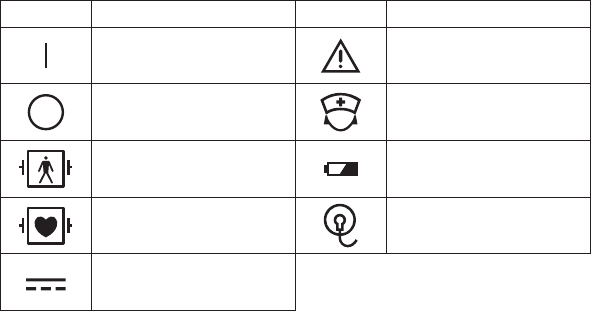
Operator’s Manual ZM-920PA/921PA/930PA/931PA vii
Explanations of the Symbols in this Manual and Instrument
The following symbols found in this manual/instrument bear the respective
descriptions as given.
Symbol Description Symbol Description
Power On Attention, consult
operator’s manual
Power Off Nurse call
Debrillationprooftype
BF applied part Replace battery
Debrillationprooftype
CF applied part Check electrode
Direct current

Operator’s Manual ZM-920PA/921PA/930PA/931PA 1
Introduction
The ZM-920PA/ZM-921PA/ZM-930PA/ZM-931PA transmitter transmits ECG and
other data from a patient to a Nihon Kohden monitor for continuous monitoring.
Available parameters and functions vary between the models. Read the operator’s
manual for the monitor before operation.
Model Parameters Functions
ZM-920PA
ZM-921PA
•ECG
• Impedance respiration
The following information is indicated
by LED.
• Check ECG electrodes
• Replace batteries
ZM-930PA
ZM-931PA
• ECG
• Impedance respiration
• SpO2
The following information is indicated
on LCD.
• SpO2 value
• Pulse wave amplitude
• Replace batteries
The following information is indicated
by LED.
• Check ECG electrodes
The transmission frequency range is as follows.
ZM-920PA/930PA: 608.0250 MHz (channel number 9002) to 613.9750 MHz
(channel number 9478)
ZM-921PA/931PA: 1395.0250 MHz (channel number E002) to 1399.9750 MHz
(channel number E398)
1427.0250 MHz (channel number E502) to 1431.9750 MHz
(channel number E898)
The transmitter channel can be changed by the QI-901PK Channel Writer. To
change the channel number, refer to the channel writer manual.

2 Operator’s Manual ZM-920PA/921PA/930PA/931PA
WARNING
The following actions must be taken to properly receive the
transmitter signal of the correct patient on the receiving instrument.
Otherwise, there may be signal loss or signals may mix causing a
serious accident, such as monitoring a different patient.
• Assign a channel administrator in the hospital and only he or she
should manage channel assignment.
• The channel administrator must manage the channels in the facility
so that there is no signal interference.
• When the transmitter channel is changed, the channel
administrator must check that the channel on the receiving monitor
is also changed and the signal is properly received.
• The channel administrator must replace the channel number label
on the transmitter with the new one after changing the channel.
WARNING
Do not use the same transmitter on more than one patient at the
same time. Do not connect different sensors on different patients to
the same transmitter.
CAUTION
• Do not use the same channel for different patients. If the same
channel is used for two patients, the two patients’ data will be lost
due to mutual modulation interference, or another patient’s data
may appear on the receiving monitor screen.
• Do not use transmitters of adjacent channels in a hospital. If a
transmitter of an adjacent channel is used, radio waves from one
transmitter affect the receiver of the adjacent channel’s transmitter
and there may be interference.
Operator’s Manual ZM-920PA/921PA/930PA/931PA 3
NOTE
• To prevent interference between channels, assign a channel
administrator in the hospital and only he or she should manage channel
assignment.
• Use Nihon Kohden parts and accessories to assure maximum
performance from your instrument.
• For stable signal reception, it is recommended to use a diversity
antenna system on the receiving monitor. Otherwise, spike noise from
transient fading of electric field strength (for example, people moving)
may interfere with the transmitter signal and may be mistaken as an
arrhythmia on the receiving monitor.
• Do not diagnose a patient based on only part of the monitoring data on
the transmitter or only on the data acquired by the transmitter. Overall
judgement must be performed by a physician who understands the
features, limitations and characteristics of the transmitter by reading
this operator’s manual thoroughly and by reading the biomedical signals
acquired by other instruments.
• For details on the receiving monitor and upgrade information, contact
your Nihon Kohden representative.
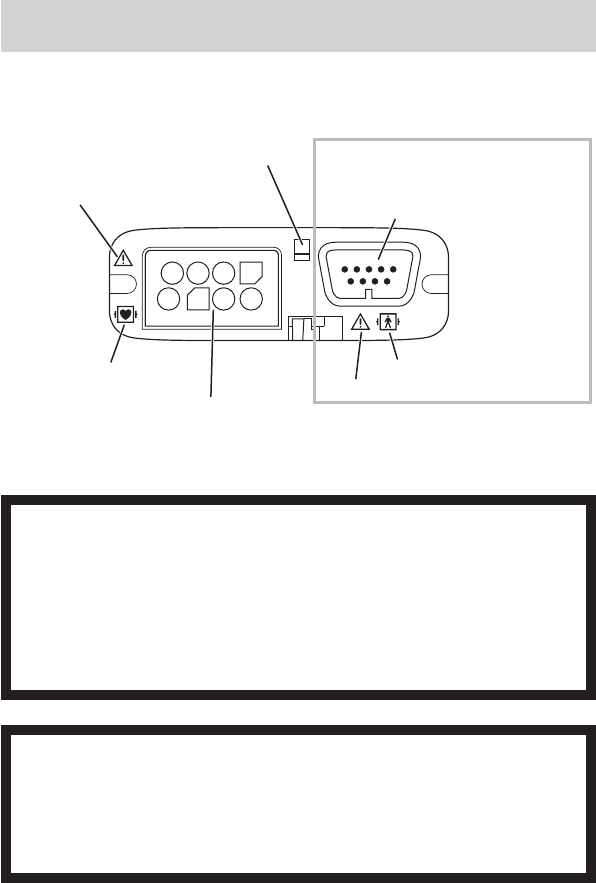
4 Operator’s Manual ZM-920PA/921PA/930PA/931PA
Panel Description
Top Panel
For attaching a strap
Refer to the warnings below
Refer to the symbol page
ECG/RESP socket
Connects to the electrode lead for measuring ECG
and/or respiration by the impedance method.
Refer to the warnings below
ZM-930PA/931PA only
SpO2 socket
Connects to the SpO2 probe.
Refer to the symbol page
WARNING
When performing defibrillation, discharge as far as possible from
electrodes, patches and any gel, cream or medicine on the chest of
the patient. If there is a possibility that the defibrillator paddle could
touch these materials, remove them from the patient. If the
defibrillator paddle directly contacts these materials, the discharged
energy may cause skin burn to the patient.
WARNING
Before defibrillation, all persons must keep clear of the bed and must
not touch the patient or any equipment or cord connected to the
patient. Failure to follow this warning may cause electrical shock or
injury.
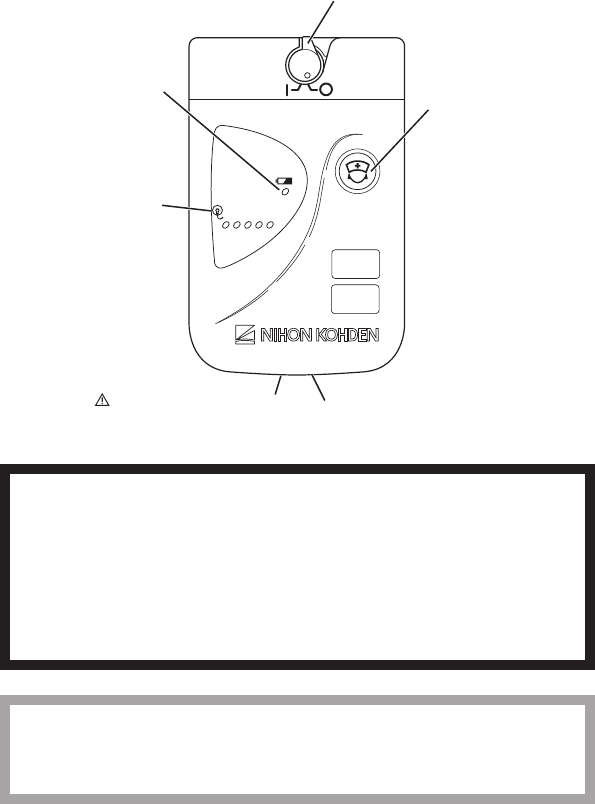
Operator’s Manual ZM-920PA/921PA/930PA/931PA 5
Front Panel
ZM-920PA/921PA
RA LA LL Va Vb
USAch
E002
1395.025 MHz
Replace batteries LED
Lights when the batteries
need replacement.
Check electrodes LED
Lights when the
electrode is detached
from the patient.
CALL key
When this key is pressed,
a “peep” sounds at the
transmitter, and “CALL”
message appears at the
monitor. Depending
on the settings on
the monitor, an ECG
waveform is recorded
when this key is pressed.
Refer to the warning below. Battery case
Contains two 1.5 V dry cell batteries (AA).
Power switch
Turns transmitter power on or off.
WARNING
Close the battery case cover during operation. If the transmitter is
used with the battery case cover open, anyone who touches the
opened battery case may receive an electrical shock when
defibrillation is performed. Touching the opened battery case may
cause electrostatic discharge and intermittently interfere with the
waveform or data.
CAUTION
Only use your finger to press the CALL key. Do not press the key with
a sharp object. Otherwise the key may be damaged.
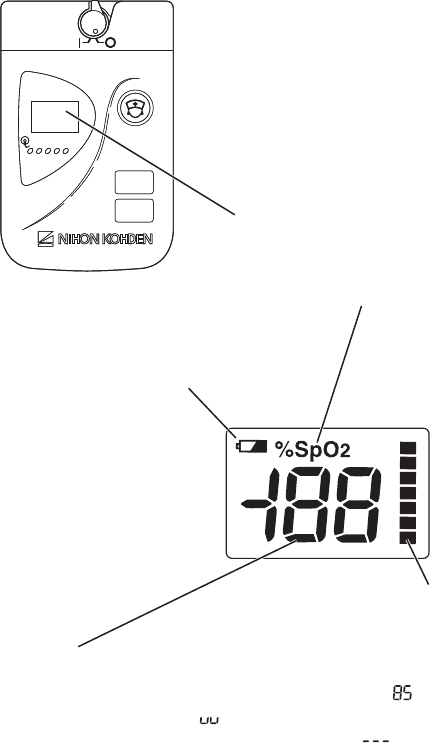
6 Operator’s Manual ZM-920PA/921PA/930PA/931PA
ZM-930PA/931PA
For the descriptions except for the
LCD, refer to the “ZM-920PA/921PA”
section on the previous page.
Battery replacement mark:
Appears when the batteries
are weak. Immediately
replace the batteries when
this appears.
%SpO2:
Displayed when the power is
turned on. This indication is not
displayed when SpO2 display is
turned off.
Pulse level bar graph:
Displays pulse level in
7 steps.
SpO2 data:
Displays SpO2 data.
When SpO2 is 41 to 100%, the value is displayed. (ex. )
When SpO2 is under 40%, “ ” is displayed.
When the detected pulse is too small to measure, “ ” is
displayed.
RA LA LL Va Vb
USAch
E002
1395.025 MHz
LCD
RA LA LL Va Vb
USAch
E002
1395.025 MHz
LCD

Operator’s Manual ZM-920PA/921PA/930PA/931PA 7
Important Safety Information
General
WARNING
Never use the transmitter in the presence of any flammable
anesthetic gas or high concentration oxygen atmosphere. Failure to
follow this warning may cause explosion or fire.
WARNING
Never use the transmitter in a hyperbaric oxygen chamber. Failure to
follow this warning may cause explosion or fire.
WARNING
Do not take this transmitter into the MRI test room. This transmitter is
not designed to be used during MRI tests.
WARNING
When performing MRI test, remove all electrodes from the patient
which are connected to this transmitter. Failure to follow this warning
may cause skin burn on the patient. For details, refer to the MRI
manual.
WARNING
When performing defibrillation, discharge as far as possible from
electrodes, patches and any gel, cream or medicine on the chest of
the patient. If there is a possibility that the defibrillator paddle could
touch these materials, remove them from the patient. If the
defibrillator paddle directly contacts these materials, the discharged
energy may cause skin burn to the patient.

8 Operator’s Manual ZM-920PA/921PA/930PA/931PA
WARNING
Before defibrillation, all persons must keep clear of the bed and must
not touch the patient or any equipment or cord connected to the
patient. Failure to follow this warning may cause electrical shock or
injury.
WARNING
When the transmitter is used with an electrosurgical unit (ESU),
firmly attach the entire area of the ESU return plate. Otherwise, the
current from the ESU flows into the electrodes of the transmitter,
causing electrical burn where the electrodes are attached. For
details, refer to the ESU manual.
WARNING
Close the battery case cover during operation. If the transmitter is
used with the battery case cover open, anyone who touches the
opened battery case may receive an electrical shock when
defibrillation is performed. Touching the opened battery case may
cause electrostatic discharge and intermittently interfere with the
waveform or data.
WARNING
If detergent or liquid spills into the transmitter, clean it and dry it
completely before use. If a wet transmitter is used, the patient or
operator may receive an electrical shock or injury.
WARNING
Do not use the same transmitter on more than one patient at the
same time. Do not connect different sensors on different patients to
the same transmitter.

Operator’s Manual ZM-920PA/921PA/930PA/931PA 9
CAUTION
Only use Nihon Kohden specified electrodes, electrode leads and
SpO2 probes. Otherwise, the maximum performance from the
transmitter cannot be guaranteed.
CAUTION
Do not reuse disposable parts and accessories.
CAUTION
Do not shake or swing the transmitter while holding the leads or
cables connected to the transmitter. The transmitter may come off
and injure someone or damage surrounding instruments.
CAUTION
Attach a strap to the transmitter to prevent the transmtiter from falling.
CAUTION
Turn off the power of mobile phones, small wireless devices and
other devices which produce strong electromagnetic interference
around a patient (except for devices allowed by the hospital
administrator). Radio waves from devices such as mobile phones or
small wireless devices may be mistaken as pulse waves and the
displayed data may be incorrect.

10 Operator’s Manual ZM-920PA/921PA/930PA/931PA
CAUTION
• Do not use the same channel for different patients. If the same
channel is used for two patients, the two patients’ data will be lost
due to mutual modulation interference, or another patient’s data
may appear on the receiving monitor screen.
• Do not use transmitters of adjacent channels in a hospital. If a
transmitter of an adjacent channel is used, radio waves from one
transmitter affect the receiver of the adjacent channel’s transmitter
and there may be interference.
Battery
WARNING
• Keep the batteries away from fire. They may explode.
• Keep the batteries away from patients.
• Never short-circuit the + and – terminals on the battery. It may
cause overheating and fire.
• Do not damage, disassemble, drop or give impact to the battery.
WARNING
If the battery is damaged and the substance inside the battery
contacts the eyes or skin, wash immediately and thoroughly with
water and see a physician. Never rub your eyes, because you may
lose your eyesight.
CAUTION
Battery replacement must be performed by the operator. When
replacing batteries of the transmitter currently used for a patient,
disconnect electrode leads from the transmitter before replacing
batteries or do not touch the patient during replacement.

Operator’s Manual ZM-920PA/921PA/930PA/931PA 11
CAUTION
The battery charger must be used outside the patient environment.
CAUTION
Refer to the battery and battery charger manuals for details on
handling the batteries.
Transmitter Channel Management
WARNING
The following actions must be taken to properly receive the
transmitter signal of the correct patient on the receiving instrument.
Otherwise, there may be signal loss or signals may mix causing a
serious accident, such as monitoring a different patient.
• Assign a channel administrator in the hospital and only he or she
should manage channel assignment.
• The channel administrator must manage the channels in the facility
so that there is no signal interference.
• When the transmitter channel is changed, the channel
administrator must check that the channel on the receiving monitor
is also changed and the signal is properly received.
• The channel administrator must replace the channel number label
on the transmitter with the new one after changing the channel.

12 Operator’s Manual ZM-920PA/921PA/930PA/931PA
For Patients Using Implantable Pacemaker
WARNING
Interaction Between Minute Ventilation Rate-Adaptive Pacemakers
and Cardiac Monitoring and Diagnostic Equipment
The bioelectric impedance measurement sensor of a minute
ventilation rate-adaptive implantable pacemaker may be affected by
transmitter which is connected to the same patient. If this occurs, the
pacemaker may pace at its maximum rate and the transmitter may
give incorrect data to the monitor. If this occurs, disconnect the
electrode leads from the patient or change the setting on the
pacemaker by referring to the pacemaker’s manual. For more details,
contact your pacemaker representative or Nihon Kohden
representative.
Output Signal
WARNING
Do not use the output signal from the receiving monitor as the
synchronization signal for other equipment such as IABP, MRI,
echocardiography or defibrillator. There may be time delay between
the monitor and the other equipment caused by waveform
transmission delay and spike noise may interfere on the output signal
and be mistaken as a trigger.

Operator’s Manual ZM-920PA/921PA/930PA/931PA 13
ECG Monitoring
CAUTION
Only use Nihon Kohden specified electrodes and electrode leads.
When other type of electrodes or electrode leads are used, the
“CHECK ELECTRODES” message may be displayed and monitoring
may stop.
CAUTION
When the “ELECTRODE OFF” or “CHECK ELECTRODE” message
is displayed on the receiving monitor, ECG is not monitored properly
and the ECG alarm does not function. Check the electrode, electrode
leads, and if necessary, replace with new ones.
SpO2 Monitoring
WARNING
SpO2 measurement may be incorrect in the following cases.
• When the patient’s carboxyhemoglobin or methemoglobin
increases abnormally.
• When dye is injected in the blood.
• When using an electrosurgical unit.
• During CPR.
• When measuring at a site with venous pulse.
• When there is body movement.
• When the pulse wave is small (insufficient peripheral circulation).

14 Operator’s Manual ZM-920PA/921PA/930PA/931PA
WARNING
Check the circulation condition by observing the skin color at the
measurement site and pulse waveform. Change the measurement
site every 8 hours for disposable probes and every 4 hours for
reusable probes (every 8 hours for TL-630T/TL-631T series probe).
The skin temperature may increase at the attached site by 2 or 3°C
(4 or 5°F) and cause a burn or pressure necrosis. When using the
probe on the following patients, take extreme care and change the
measurement site more frequently according to symptoms and
degree.
• Patient with a fever
• Patient with peripheral circulation insufficiency
• Neonate or low birth weight infant with delicate skin
• Patient who is receiving photodynamic therapy*
* Photodynamic therapy is a treatment to remove the affected tissue by using a
photosensitizing agent and exposing the tissue to light. This treatment has a side
effectofphotosensitivityandthelightfromthengerprobesensormaycause
a burn. This probe uses two light wavelengths in the range from 650 to 950 nm.
The maximum light intensity is less than 5.5 mW/sr.
WARNING
When not monitoring SpO2, disconnect the SpO2 cable from the
transmitter. Otherwise, noise from the probe sensor may interfere and
incorrect data is displayed on the screen.

Operator’s Manual ZM-920PA/921PA/930PA/931PA 15
WARNING
• When using the TL-201T finger probe, do not fasten the probe and
cable to the finger by wrapping with tape. This may cause burn,
congestion or pressure necrosis from poor blood circulation.
• When using probes other than the TL-201T finger probe, to avoid
poor circulation, do not wrap the tape too tight. Check the blood
circulation condition by observing the skin color and congestion at
the skin peripheral to the probe attachment site. Even for short-
term monitoring, there may be burn or pressure necrosis from
poor blood circulation, especially on neonates or low birth weight
infants whose skin is delicate. Accurate measurement cannot be
performed on a site with poor peripheral circulation.
CAUTION
While a patient is on medication which causes vasodilation, the pulse
waveform may change and in rare cases the SpO2 value might not be
displayed.
CAUTION
Normal external light does not affect monitoring but strong light such
as a surgical light or sunlight may affect monitoring. If affected, cover
the measuring site with a blanket.
CAUTION
If the attachment site is dirty with blood or bodily fluids, clean the
attachment site before attaching the probe. If there is nail polish on
the attachment site, remove the polish. Otherwise, the amount of
transmitted light decreases, and measured value may be incorrect or
measurement cannot be performed.

16 Operator’s Manual ZM-920PA/921PA/930PA/931PA
CAUTION
Do not use a probe which is deteriorated by aging. Accurate
measurement cannot be performed.
CAUTION
Do not use a damaged or disassembled probe. It causes incorrect
measurement and may injure the patient.
CAUTION
The disposable probe is not sterilized. Use the disposable probe only
for a single patient. Never reuse the disposable probe for another
patient because it causes cross infection.
CAUTION
If the skin gets irritated or redness appears on the skin from the
probe, change the attachment site or stop using the probe. Take
extreme care for the patients with delicate skin.
CAUTION
Do not pull or bend the probe cable, and do not put caster feet on the
probe cable. Do not immerse the probe cable in chemical solutions or
water. Failure to follow these instructions may cause cable
discontinuity, short circuit, skin burn on the patient and incorrect
measurement data. Replace any broken probe with a new one.
CAUTION
When the probe is attached on an appropriate site with sufficient
circulation and the error message confirming the probe attachment
repeatedly appears, the probe may be deteriorated. Replace it with a
new one.

Operator’s Manual ZM-920PA/921PA/930PA/931PA 17
CAUTION
When a message indicates a faulty probe, stop monitoring and
replace the probe with a new one.
CAUTION
When any of the following conditions occurs, the probe may be
broken. Replace it with a new one.
• The transmitter generates “pip” sounds.
• SpO2 data is 85% and blinking.
CAUTION
Neonatal skin is delicate. Remove the probe and tape carefully and
slowly.
CAUTION
When removing a probe that is taped to the skin, do not pull the
probe cable because this can damage the cable.
CAUTION
When removing the probe from the attachment tape, do not pull the
sensor cable because this can damage the cable.
CAUTION
Do not immerse the disposable probe in detergents or water. If the
probe adhesive surface gets wet, adhesiveness becomes weak and
the probe cannot be attached to the skin.
CAUTION
Refer to the probe instruction manual for details.

18 Operator’s Manual ZM-920PA/921PA/930PA/931PA
Maintenance
CAUTION
If detergent or liquid spills into the transmitter, clean it and dry it
completely before use. If a wet transmitter is used, the transmitter
may malfunction or get damaged.
CAUTION
Never disassemble or repair the transmitter. Disassembly and repair
must be performed by qualified service personnel.
CAUTION
Before cleaning or disinfection, remove the batteries from the
transmitter. Failure to follow this instruction may result in electrical
shock or transmitter malfunction.
CAUTION
The transmitter cannot be sterilized. Sterilizing the transmitter may
damage it.

Operator’s Manual ZM-920PA/921PA/930PA/931PA 19
Preparation
Installing (Replacing) Batteries
Use two AA(R6) type alkaline dry cell batteries, manganese dry cell batteries,
NiCd rechargeable batteries or NiMH batteries.
Battery Lifetime
With new alkaline batteries, the transmitter can continuously measure for the
following number of days. Operation time depends on the thickness of the SpO2
probe attachment site.
Transmitter Operating time (Measuring parameters)
ECG, Resp, SpO2ECG, Resp
ZM-920PA/930PA 3 days 4 days
ZM-921PA/931PA 2.5 days 3.5 days
NOTE
The capacity of manganese, NiCd and NiMH batteries is less than that of
alkaline batteries, therefore the lifetime of the battery is shorter.
Type Lifetime
Manganese About 1/2 of alkaline batteries
NiCd About 1/3 of alkaline batteries (when fully charged)
NiMH About 1/2 of alkaline batteries (when fully charged)
Recommended Batteries
Alkaline primary: Nihon Kohden Medipower (equivalent to Panasonic LR6 (G))
CAUTION
Battery replacement must be performed by the operator. When
replacing batteries of the transmitter currently used for a patient,
disconnect electrode leads from the transmitter before replacing
batteries or do not touch the patient during replacement.
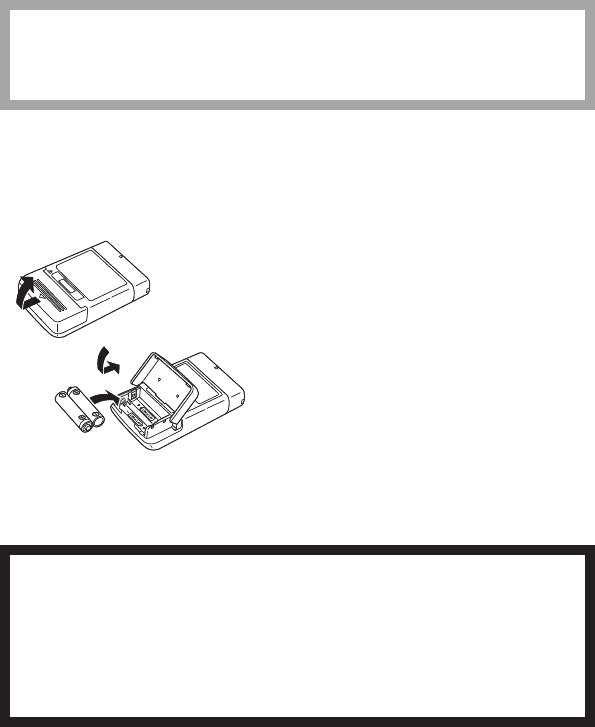
20 Operator’s Manual ZM-920PA/921PA/930PA/931PA
If electrode leads are attached to the patient and the person replacing the batteries
touches the patient, the patient leakage current over the amount allowed may
occur.
CAUTION
• Replace all batteries at the same time.
• Do not use different types of batteries together.
NOTE
Insert the batteries with the correct polarity (+ and −).
Procedure
1. Open the battery case cover.
2. Insert two dry cell batteries (LR6) into
the battery case observing the correct
polarity.
3. Close the cover and press it gently
until it clicks.
WARNING and CAUTION for Battery Handling
WARNING
• Keep the batteries away from fire. They may explode.
• Keep the batteries away from patients.
• Never short-circuit the + and – terminals on the battery. It may
cause overheating and fire.
• Do not damage, disassemble, drop or give impact to the battery.
1
2
3
1
2
3

Operator’s Manual ZM-920PA/921PA/930PA/931PA 21
WARNING
If the battery is damaged and the substance inside the battery
contacts the eyes or skin, wash immediately and thoroughly with
water and see a physician. Never rub your eyes, because you may
lose your eyesight.
CAUTION
Do not handle the batteries with wet hands.
CAUTION
When the transmitter is not in use, remove batteries. When batteries
are installed, battery power is consumed even if measurement is not
performed. Especially, when NiMH batteries remain in the transmitter
when the transmitter is not in use, the battery may become unusable
from overdischarge and leak liquid which will damage the transmitter.
CAUTION
Refer to the battery and battery charger manuals for details on
handling the batteries.
CAUTION
The battery charger must be used outside the patient environment.
NOTE
• When using rechargeable NiCd batteries or NiMH batteries, shallow
charging/discharging shortens battery capacity. For details, refer to the
battery operator’s manual.
• Remove the batteries from the transmitter before disposing of the
transmitter.
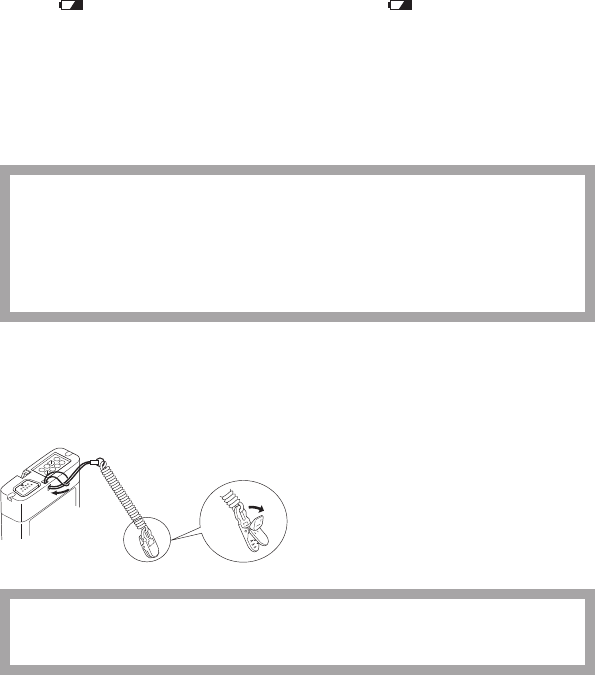
22 Operator’s Manual ZM-920PA/921PA/930PA/931PA
Situations Requiring Battery Replacement
Replace the batteries when any of the following occurs.
• The “ ” LED lights (ZM-920PA/921PA) or the “ ” mark is displayed on
the LCD (ZM-930PA/931PA) on the transmitter.
• The transmitter generates a constant alarm (continuous “peep” sound).
• The monitor displays the battery replacement message on the screen.
• When the power of the LCD transmitter is turned on, no message or icon is
displayed. (Only the ZM-930PA/931PA).
CAUTION
When using batteries other than alkaline, the interval between the
battery replacement indication and battery discharge may be shorter.
Replace the batteries immediately upon battery replacement
indication.
Attaching a Strap to the Transmitter
To open the clip, firmly pull out the
tab in direction of the arrow.
CAUTION
Attach a strap to the transmitter to prevent the transmtiter from falling.
NOTE
Do not attach the clip to hard objects such as thick cloth or zippers, or the
clip may break.
Attach a strap to the transmitter and fasten the clip to the patients’ clothes or bed
sheets.
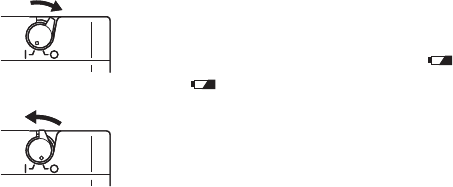
Operator’s Manual ZM-920PA/921PA/930PA/931PA 23
If the transmitter falls off, the battery cover may be opened. If the patient touches
the terminals of the batteries, patient leakage current over the allowable amount
can occur.
Turning On/Off the Transmitter
Check Items Before Turning On the Power
To use the instrument in a safe and optimum condition, before turning on the
transmitter power switch, check the following.
Appearance
• There is no damage or dirt on the outside of the transmitter. (Power switch,
LED, LCD, CALL key, junction, battery case cover, battery case, etc.)
• The transmitter is completely dry.
• The electrode lead is not broken.
• There is no damage or dirt on the SpO2 probe or on the disposable electrodes.
Battery
• The battery polarity is correct.
• Thebatterycasespringisrmlyxedandthebatteryisnotloose.
• Thebatterycasecoverisrmlyclosed.
Channel Setting
• The transmitter channel corresponds to those of the receiving monitor.
• The same channel is not being used on a different transmitter in the surrounding
area.
Turning On/Off the Power
To turn on the power, turn the power switch to the right.
After a “peep” sound for about one second, the power is
turned on.
(There is no “peep” sound when the “ ” LED light or
the “ ” are blinking on the LCD).
To turn off the power, turn the power switch to the left.
ON
OFF
ON
OFF

24 Operator’s Manual ZM-920PA/921PA/930PA/931PA
Check Items After Turning On the Power
After turning on the power, check the following items.
Power On
• The power switch is not damaged.
• The transmitter generates a “peep” sound for about one second.
• All LEDs light and values are displayed on the LCD for about one second.
• The transmitter does not generate a continuous “pip” sound.
• The transmitter does not liberate excessive heat.
• The “ ” LED does not light or the “ ” mark is not displayed on the LCD.
• The transmitter does not interfere with the operation of medical instruments
used near it.
Basic Operation
• The “signal loss” message is not displayed on the monitor when the transmitter
is inside the receiving range of the monitor.
• A “peep” sounds at the transmitter and “CALL” message appears at the
receiving monitor when the CALL key is pressed and the transmitter is inside
the receiving range of the monitor.
• The battery replacement message is not displayed on the monitor.
Check Items After the Power Off
• ECG electrode leads and SpO2 probe are cleaned and disinfected.
• When the transmitter gets wet, liquid is wiped off and the transmitter is
thoroughly dried.
• There are enough consumables, such as disposable electrodes.
• The power is turned off.
• The batteries are removed from the transmitter when it will not be used for a
long time.
• Dead batteries are disposed of properly.

Operator’s Manual ZM-920PA/921PA/930PA/931PA 25
ECG Monitoring
When 6 leads are used on this transmitter, up to 8 lead (I, II, III, aVR, aVL, aVF,
Va and Vb) of ECG waveforms can be displayed on the receiving monitor. The
heart rate is also measured. When 3 leads are used, one channel ECG waveform of
lead II can be displayed on the receiving monitor. Refer to the operator’s manual
of the monitor for details.
WARNING
Interaction Between Minute Ventilation Rate-Adaptive Pacemakers
and Cardiac Monitoring and Diagnostic Equipment*
The bioelectric impedance measurement sensor of a minute
ventilation rate-adaptive implantable pacemaker may be affected by
transmitter which is connected to the same patient. If this occurs, the
pacemaker may pace at its maximum rate and the transmitter may
give incorrect data to the monitor. If this occurs, disconnect the
electrode leads from the patient or change the setting on the
pacemaker by referring to the pacemaker’s manual. For more details,
contact your pacemaker representative or Nihon Kohden
representative.
* Minute ventilation is sensed in rate-adaptive pacemakers by a technology
known as bioelectric impedance measurement (BIM). Many medical devices in
addition to pacemakers use this technology. When one of these devices is used
on a patient with an active, minute ventilation rate-adaptive pacemaker, the
pacemaker may erroneously interpret the mixture of BIM signals created in the
patient, resulting in an elevated pacing rate.
For more information, see the FDA web site.
http://www.fda.gov/cdrh/safety.html

26 Operator’s Manual ZM-920PA/921PA/930PA/931PA
WARNING
When the transmitter is used with an electrosurgical unit (ESU),
firmly attach the entire area of the ESU return plate. Otherwise, the
current from the ESU flows into the electrodes of the transmitter,
causing electrical burn where the electrodes are attached. For
details, refer to the ESU manual.
NOTE
• This transmitter is not protected against noise generated from an
electrosurgical unit.
• If an electric blanket is used and incorrect heart rate is displayed on the
monitor, turn off the pacing pulse detection on the monitor.
ECG Measurement Procedure
1. Select the type of electrode lead and disposable electrode according to the
purpose.
2. Connect the electrode lead to the ECG/RESP socket.
3. Connect disposable electrodes to the electrode lead and attach electrodes to
the patient.
Aftersteps1to3arenished,ECGmonitoringautomaticallystarts.
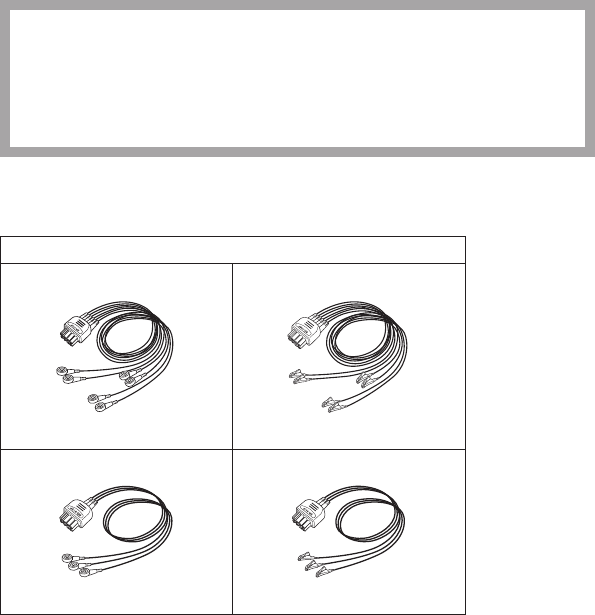
Operator’s Manual ZM-920PA/921PA/930PA/931PA 27
Selecting Electrode Lead and Disposable Electrode
CAUTION
Only use Nihon Kohden specified electrodes and electrode leads.
When other type of electrodes or electrode leads are used, the
“CHECK ELECTRODES” message may be displayed and monitoring
may stop.
Option
Electrode lead
BR-916PA
6 electrodes, snap type
BR-906PA
6 electrodes, clip type
BR-913PA
3 electrodes, snap type
BR-903PA
3 electrodes, clip type
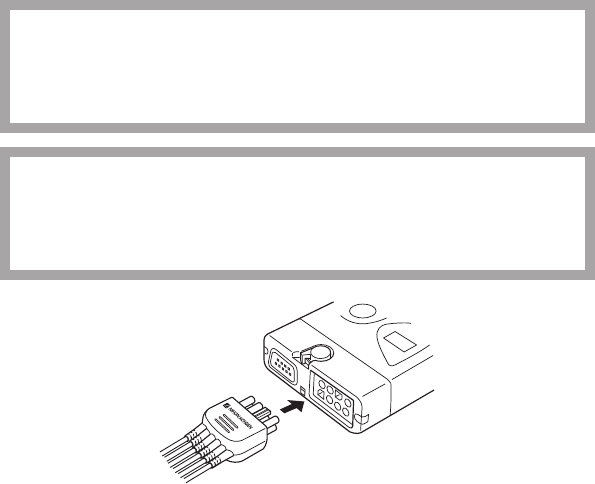
28 Operator’s Manual ZM-920PA/921PA/930PA/931PA
Connecting the Electrode Lead to the Transmitter
Connect the electrode lead to the ECG/RESP socket on the transmitter.
CAUTION
Do not shake or swing the transmitter while holding the leads or
cables connected to the transmitter. The transmitter may come off
and injure someone or damage surrounding instruments.
CAUTION
Hold the connector of the electrode lead when connecting/
disconnecting the electrode lead. If you disconnect the electrode lead
by pulling the lead, it damages the electrode lead.
Selecting the Electrode Position
Follow the physician’s instructions for electrode placement when available.
For ECG monitoring, electrodes are attached only on the chest to allow patient
movement and obtain continuous stable ECG. Following leads are examples.
When also monitoring respiration, refer to the “Electrode Position for Respiration
Monitoring” section.
NOTE
The optimum electrode positions for ECG measurement of a patient
are not always optimum for respiration measurement of the patient.
Select positions suitable for both ECG and respiration measurements, or
positions which have priority for one measurement.
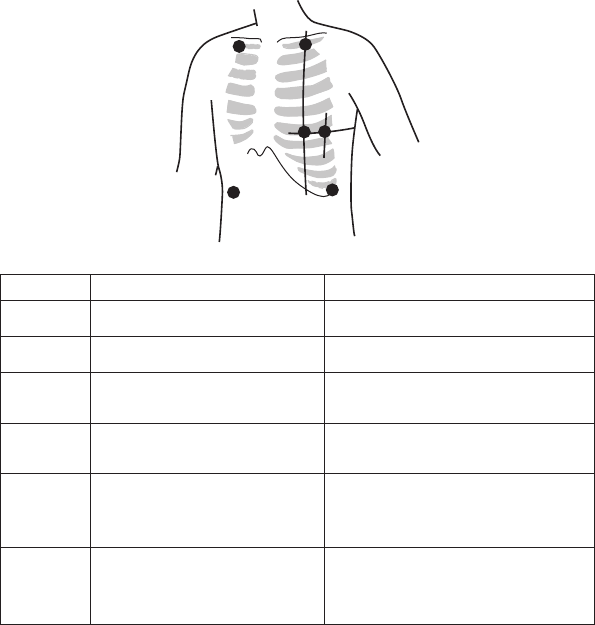
Operator’s Manual ZM-920PA/921PA/930PA/931PA 29
Six Electrodes
Electrode Position
The 6-electrode method with lead II and lead V5 is effective for monitoring
myocardial ischemia. You can improve monitoring accuracy considerably by
adding lead V4 to this combination. Va and Vb can be at any position of the
standard 12 leads V1 to V6, but V4 and V5 are most appropriate for myocardial
ischemic monitoring.
RA LA
N (RL) LL
Va Vb
Symbol Lead Color (Clip Color) Electrode Position
RA White (White) Right infraclavicular fossa
LA Black (Black) Left infraclavicular fossa
LL Red (Red) Lowest rib on the left anterior
axillary line
N (RL) Green (Green) Right anterior axillary line at the
same level as LL
Va Brown (Brown) (BR-906PA)
Brown-blue (BR-916PA)
Fifth intercostal space on the left
midclavicular line. (V4 position of
standard 12 leads)
Vb Brown (Brown) (BR-906PA)
Brown-orange (BR-916PA)
Left anterior axillary line at the
same level as Va. (V5 position of
standard 12 leads)
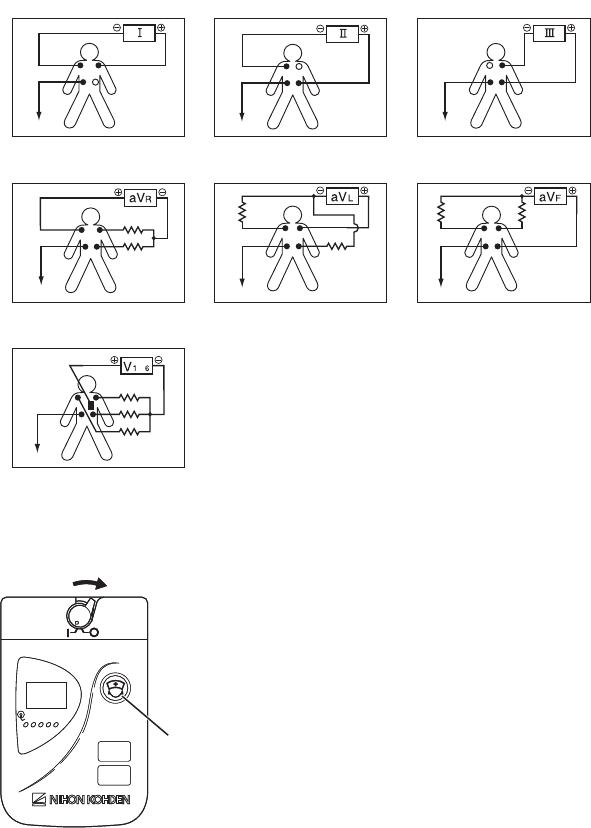
30 Operator’s Manual ZM-920PA/921PA/930PA/931PA
Lead Position
Standard limb leads
Monopolar limb leads
Monopolar chest leads
Lead I
Lead I Lead II Lead III
aVR lead aVL lead aVF lead
V1 to V6 leads
V1 to V6 leads
to
RA
RA
RA RA RA
RA
RA
LA
LA
LA
LA
LA
LA
LA
LL
LL
LL
LL LL
LL
LL
N (RL)
N (RL)
N (RL) N (RL) N (RL)
N (RL)
N (RL)
When Using 4 to 6 DIN Type Leads to Monitor 6 Lead ECG
When the BR-906PA/916PA electrode
leadsarenotused,thetransmitterisxed
to 3 lead ECG monitoring. To monitor 6
lead ECG using 4 to 6 DIN type leads,
thetransmittermustbexedto6lead
monitoring.Toxtransmittertothe6lead
ECG monitoring, turn off the transmitter
power, press and hold the CALL key and
turn on the transmitter power.
When the transmitter power is turned off
and on again, the monitoring mode returns
to the original mode.
ON
RA LA LL Va Vb
USAch
E002
1395.0250 MHz
CALL key
ON
RA LA LL Va Vb
USAch
E002
1395.0250 MHz
CALL key
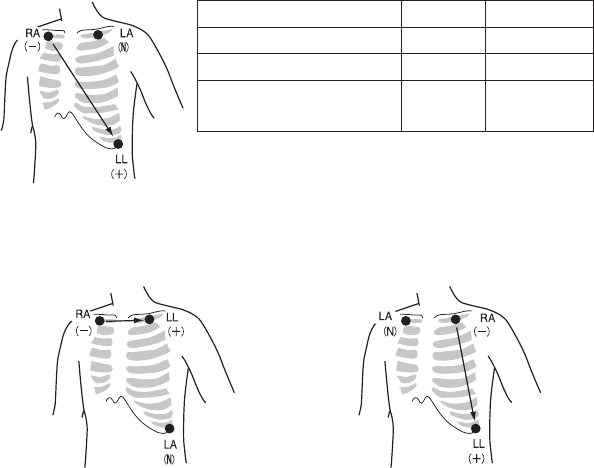
Operator’s Manual ZM-920PA/921PA/930PA/931PA 31
Three Electrodes
By using the optional BR-913PA/903PA electrode lead, 3 lead ECG monitoring is
available.
Electrode Position
• Lead MII, which is similar to standard lead II, used when ECG measurement
has priority
Electrode Position Symbol Lead Color
Left infraclavicular fossa LA (N) Black
Right infraclavicular fossa RA (−)White
Below lowest rib on the
left anterior axillary line LL (+) Red
• Lead MI, which is similar to standard
lead I
Change LL and LA of the lead MII.
• Lead MIII, which is similar to
standard lead III
Change RA and LA of the lead MII.
If the electrode position shown above is not available due to chest surgery, attach
the electrodes to the root of the limbs or below the clavicles for stable ECG
monitoring.
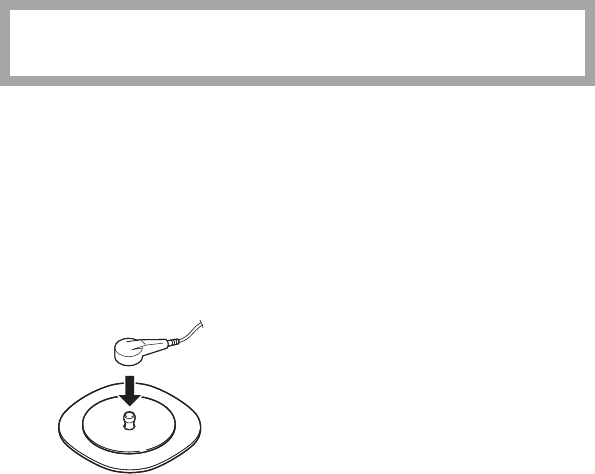
32 Operator’s Manual ZM-920PA/921PA/930PA/931PA
Connecting the Electrode Lead and Disposable
Electrodes
Preparing the Patient Skin
Shave off excessive body hair.
To reduce skin impedance, clean the electrode site with cream or with a cotton pad
moistened with the electrode site with cream or with a cotton pad moistened with
alcohol. Thoroughly dry the skin with a clean cotton pad.
NOTE
• For a patient with frequent body movement, rub the sites with Skinpure
skin preparation gel. However, do not use Skinpure skin preparation gel
for sensitive skin.
• Do not place electrodes on a wound or on an inflamed, wrinkled or
uneven skin surface.
Attaching Electrodes to the Patient
CAUTION
Do not reuse disposable parts and accessories.
NOTE
• To maintain good contact between the electrode and skin, check that the
paste of the disposable electrode is not dry.
• When contact between the disposable electrode and skin becomes
poor, replace electrodes with new ones immediately. Otherwise, contact
impedance between the skin and the electrode increases and the
correct ECG cannot be obtained.
Refer to the electrode operator’s manual for details.
1. Connect the electrode lead to the electrode.
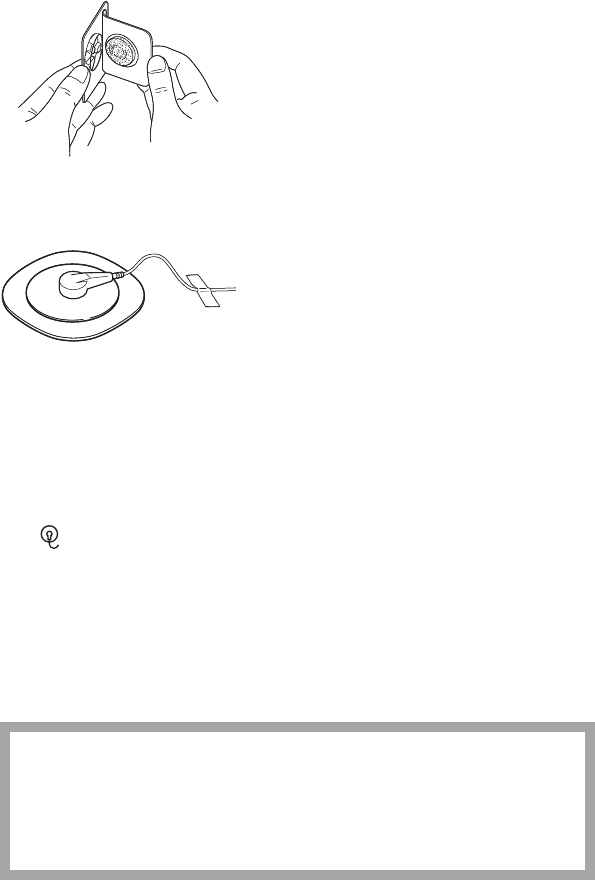
Operator’s Manual ZM-920PA/921PA/930PA/931PA 33
2. Carefully remove the backing paper from
the electrode. Avoid touching the adhesive
surface.
3. Place the electrode on the previously
cleaned skin. Pay attention to the electrode
lead color and symbol.
4. Fasten the electrode lead wire with surgical
tape with an extra length of wire between
the tape and the electrode. This lessens
the movement of electrode leads by body
movement and helps stable monitoring.
Detection and Display of Measurement Condition
Electrode Detachment
The “ ” LED lights on the transmitter or the “CHECK ELECTRODE” message
is displayed on the screen of the monitor in the following cases.
• Electrode is detached from skin.
• Electrode lead is disconnected from the electrode.
• Polarization voltage between the electrode and skin is excessively high.
In these cases, check the cause and if necessary, replace electrodes with new ones.
CAUTION
When the “ELECTRODE OFF” or “CHECK ELECTRODE” message
is displayed on the receiving monitor, ECG is not monitored properly
and the ECG alarm does not function. Check the electrode, electrode
leads, and if necessary, replace with new ones.

34 Operator’s Manual ZM-920PA/921PA/930PA/931PA
Respiration Monitoring
Respiration is monitored by measuring changes in impedance between the RA
and LL ECG electrodes. This transmitter sends the changes in impedance to the
monitor as a respiration waveform. The monitor displays the respiration waveform
and calculates respiration rate. Refer to the operator’s manual of the monitor for
details.
WARNING
Interaction Between Minute Ventilation Rate-Adaptive Pacemakers
and Cardiac Monitoring and Diagnostic Equipment*
The bioelectric impedance measurement sensor of a minute
ventilation rate-adaptive implantable pacemaker may be affected by
transmitter which is connected to the same patient. If this occurs, the
pacemaker may pace at its maximum rate and the transmitter may
give incorrect data to the monitor. If this occurs, disconnect the
electrode leads from the patient or change the setting on the
pacemaker by referring to the pacemaker’s manual. For more details,
contact your pacemaker representative or Nihon Kohden
representative.
* Minute ventilation is sensed in rate-adaptive pacemakers by a technology
known as bioelectric impedance measurement (BIM). Many medical devices
in addition to pacemakers use this technology. When one of these devices is
used on a patient with an active, minute ventilation rate-adaptive pacemaker,
thepacemaker may erroneously interpret the mixture of BIM signals created in
the patient, resulting in an elevated pacing rate.
For more information, see the FDA web site.
http://www.fda.gov/cdrh/safety.html
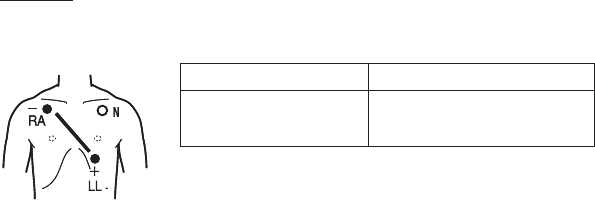
Operator’s Manual ZM-920PA/921PA/930PA/931PA 35
Respiration Measurement Procedure
1. Select the electrode lead and disposable electrodes.
2. Connect the electrode lead to the ECG/RESP socket.
3. Connect disposable electrodes to the electrode lead and attach electrodes to
the patient.
Aftersteps1to3arenished,respirationmonitoringautomaticallystarts.
Electrode Position for Respiration Monitoring
Place the RA and LL electrodes so that the lungs are between the electrodes.
NOTE
The optimum electrode positions for ECG measurement of a patient
are not always optimum for respiration measurement of the patient.
Select positions suitable for both ECG and respiration measurements, or
positions which have priority for one measurement.
Electrode Position Examples
NOTE
The following examples are when monitoring with 3 electrodes. ECG
cannot be monitored correctly when electrodes are attached as the
following examples when monitoring with 6 electrodes.
Position 1
In this position, respiration measurement is available; however, there is a
difference in amplitude between different patients.
RA LL
Right infraclavicular
fossa
Fifth intercostal space on the
left midclavicular line, V4
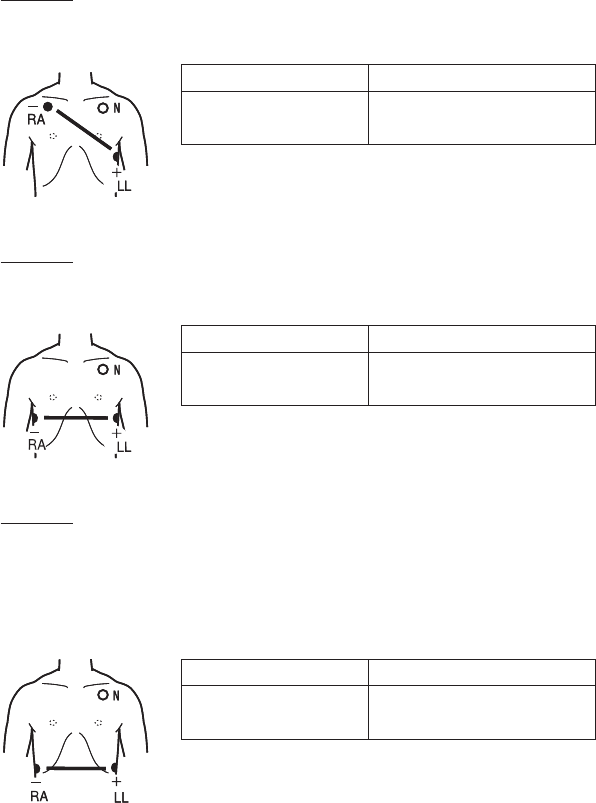
36 Operator’s Manual ZM-920PA/921PA/930PA/931PA
Position 2
In this position, the waveform amplitude is usually large and the ECG lead is
similar to Lead MII. This position can be generally recommended.
RA LL
Right infraclavicular
fossa
Fifth intercostal space on the
left midaxillary line, V6
Position 3
In this position, the respiration waveform is optimum, but the ECG lead is
unusual.
RA LL
Right midaxillary at the
horizontal level of V4
Fifth intercostal space on the
left midaxillary line, V6
Position 4
Inthisposition,therespirationmeasurementisinuencedbytheimpedance
variation of the abdomen, so the cardiac pulse wave included in the respiration
wave is reduced. Note that the waveform is inverted in phase compared with the
chestmovement(thewaveformgoesdownduringinspiration).Itisdifcultto
measure the ECG at the same time.
RA LL
Lowest rib on the right
anterior axillary line
Lowest rib on the left anterior
axillary line

Operator’s Manual ZM-920PA/921PA/930PA/931PA 37
SpO2 Monitoring
The SpO2 monitoring is only available on the ZM-930PA/931PA transmitter.
This transmitter sends SpO2 and pulse waveform to the monitor and displays SpO2
data and pulse level bar graph on the LCD.
Refer to the operator’s manual of the monitor for details.
WARNING
SpO2 measurement may be incorrect in the following cases.
• When the patient’s carboxyhemoglobin or methemoglobin
increases abnormally.
• When dye is injected in the blood.
• When using an electrosurgical unit.
• During CPR.
• When measuring at a site with venous pulse.
• When there is body movement.
• When the pulse wave is small (insufficient peripheral circulation).
WARNING
When not monitoring SpO2, disconnect the SpO2 cable from the
transmitter. Otherwise, noise from the probe sensor may interfere and
incorrect data is displayed on the screen.

38 Operator’s Manual ZM-920PA/921PA/930PA/931PA
WARNING
Check the circulation condition by observing the skin color at the
measurement site and pulse waveform. Change the measurement
site every 8 hours for disposable probes and every 4 hours for
reusable probes (every 8 hours for TL-630T/TL-631T series probe).
The skin temperature may increase at the attached site by 2 or 3°C
(4 or 5°F) and cause a burn or pressure necrosis. When using the
probe on the following patients, take extreme care and change the
measurement site more frequently according to symptoms and
degree.
• Patient with a fever
• Patient with peripheral circulation insufficiency
• Neonate or low birth weight infant with delicate skin
• Patient who is receiving photodynamic therapy*
* Photodynamic therapy is a treatment to remove the affected tissue by using a
photosensitizing agent and exposing the tissue to light. This treatment has a side
effectofphotosensitivityandthelightfromthengerprobesensormaycause
a burn. This probe uses two light wavelengths in the range from 650 to 950 nm.
The maximum light intensity is less than 5.5 mW/sr.
CAUTION
Turn off the power of mobile phones, small wireless devices and
other devices which produce strong electromagnetic interference
around a patient (except for devices allowed by the hospital
administrator). Radio waves from devices such as mobile phones or
small wireless devices may be mistaken as pulse waves and the
displayed data may be incorrect.
CAUTION
Normal external light does not affect monitoring but strong light such
as a surgical light or sunlight may affect monitoring. If affected, cover
the measuring site with a blanket.

Operator’s Manual ZM-920PA/921PA/930PA/931PA 39
CAUTION
Do not pull or bend the probe cable, and do not put caster feet on the
probe cable. Do not immerse the probe cable in chemical solutions or
water. Failure to follow these instructions may cause cable
discontinuity, short circuit, skin burn on the patient and incorrect
measurement data. Replace any broken probe with a new one.
CAUTION
When the probe is attached on an appropriate site with sufficient
circulation and the error message confirming the probe attachment
repeatedly appears, the probe may be deteriorated. Replace it with a
new one.
CAUTION
While a patient is on medication which causes vasodilation, the pulse
waveform may change and in rare cases the SpO2 value might not be
displayed.
NOTE
ZM-930PA only
When monitoring SpO2, monitor ECG at the same time. The ECG
electrode lead works as an antenna for transmitting data from the
transmitter to the receiving monitor. If ECG is not measured, the telemetry
signal may not be received.

40 Operator’s Manual ZM-920PA/921PA/930PA/931PA
Measurement Procedure
1. Select the SpO2 probe.
2. Connect the SpO2 probe to the SpO2 socket.
3. Attach the SpO2 probe to the patient.
Aftersteps1to3arenished,SpO2 monitoring automatically starts.
Selecting SpO2 Probe
Select an appropriate probe for the patient.
CAUTION
Only use Nihon Kohden specified electrodes, electrode leads and
SpO2 probes. Otherwise, the maximum performance from the
transmitter cannot be guaranteed.
CAUTION
Do not use a damaged or disassembled probe. It causes incorrect
measurement and may injure the patient.
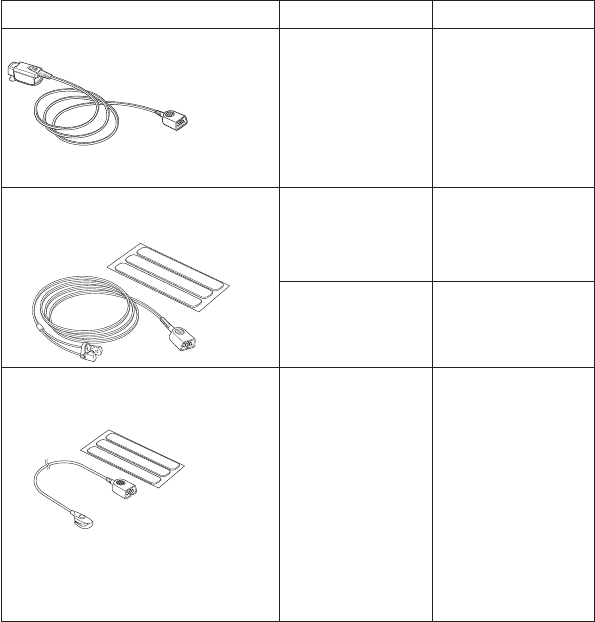
Operator’s Manual ZM-920PA/921PA/930PA/931PA 41
Reusable Probes
WhenusingaTL-201Tngerprobe,choosetheappropriatecablelengthfor
attachment.
Model Subject (Weight) Attachment Site
Finger Probe TL-201T
Cable length: 60 cm or 160 cm
Adult or child
(20 kg or more)
Finger
Multi-site probe TL-220T
Attachment
tape
Adult or Infant
(3 kg or more)
Finger or toe
Neonate
(3 kg or less)
Instep and sole
Finger probe
TL-630T1/630T3/631T1/631T3
Attachment tape
Cable length:
TL-630T1/631T1: 60 cm
TL-630T3/631T3: 160 cm
TL-630T1/630T3:
Adult or child
(50 kg or more)
TL-631T1/631T3:
Adult or child
(20 kg or more)
Finger or toe
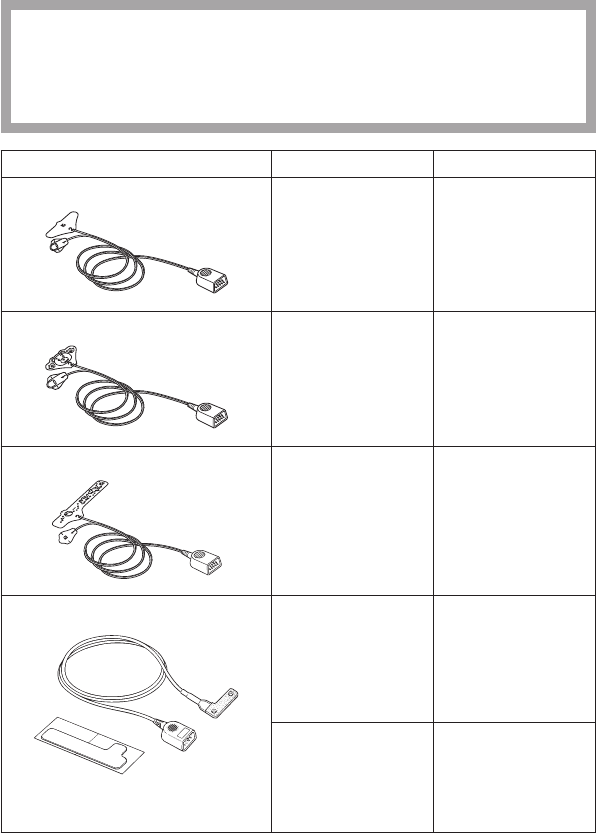
42 Operator’s Manual ZM-920PA/921PA/930PA/931PA
Disposable Probes
CAUTION
The disposable probe is not sterilized. Use the disposable probe only
for a single patient. Never reuse the disposable probe for another
patient because it causes cross infection.
Model Subject (Weight) Attachment Site
TL-251T Adult
(30 kg or more)
Finger or toe
TL-252T Child
(3 to 40 kg)
Finger or toe
TL-253T Neonate
(3 kg or less)
Instep and sole
TL-051S/052S
Cable length TL-051S: 80 cm
TL-052S: 160 cm
Adult
(50 kg or more)
Finger
Neonate
(3 kg or less)
Instep and sole
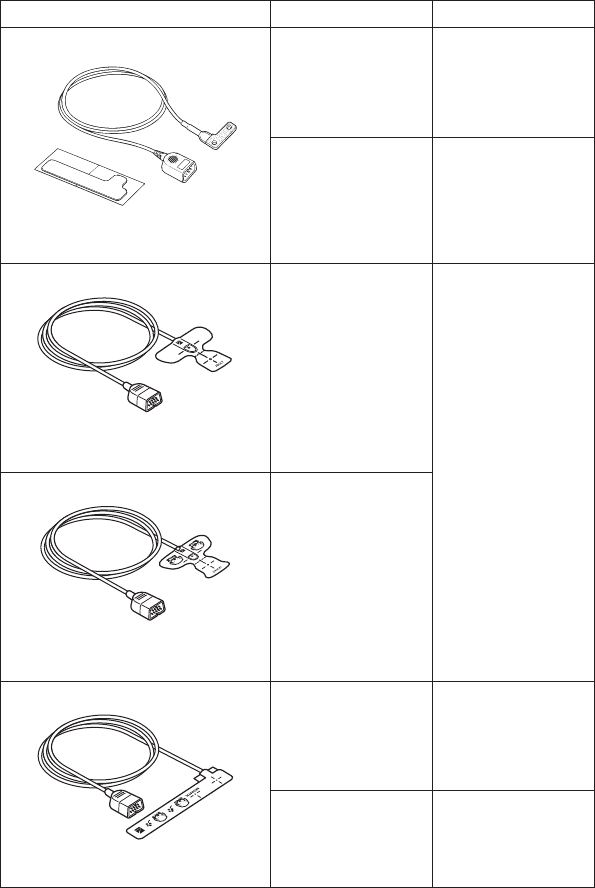
Operator’s Manual ZM-920PA/921PA/930PA/931PA 43
Model Subject (Weight) Attachment Site
TL-061S/062S
Cable length TL-061S: 80 cm
TL-062S: 160 cm
Adult, child
(15 to 50 kg)
Finger
Child, infant
(3 to 15 kg)
Toe
TL-271T/271T3
Cable length TL-271T: 80 cm
TL-271T3: 160 cm
Adult
(30 kg or more)
Finger or toe
TL-272T/272T3
Cable length TL-272T: 80 cm
TL-272T3: 160 cm
Child
(10 to 50 kg)
TL-273T/273T3
Cable length TL-273T: 80 cm
TL-273T3: 160 cm
Neonate
(3 kg or less)
Instep and sole
Adult
(40 kg or more)
Finger or toe
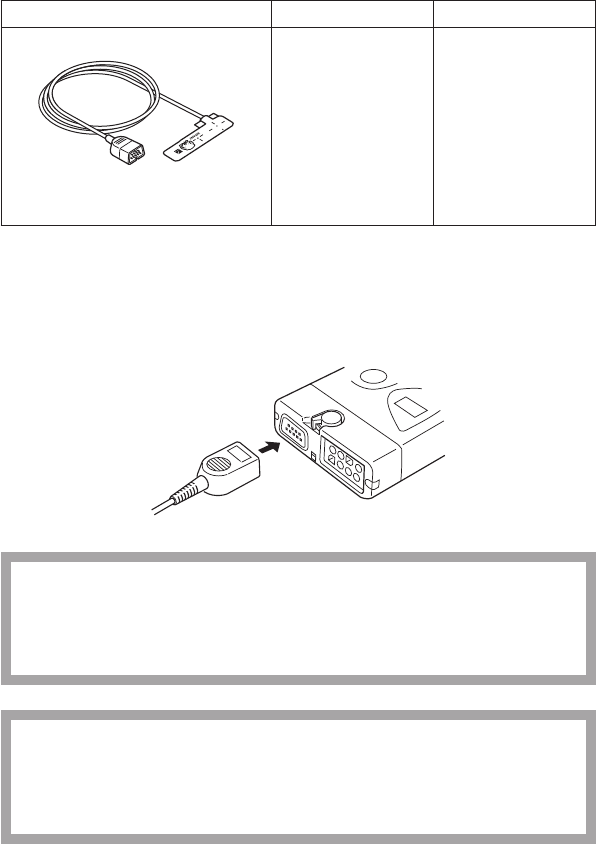
44 Operator’s Manual ZM-920PA/921PA/930PA/931PA
Model Subject (Weight) Attachment Site
TL-274T/274T3
Cable length TL-274T: 80 m
TL-274T3: 160 cm
Infant
(3 to 20 kg)
Finger or toe
Connecting SpO2 Probe to the Transmitter
Connect the probe to the SpO2 socket on the transmitter.
CAUTION
Do not shake or swing the transmitter while holding the leads or
cables connected to the transmitter. The transmitter may come off
and injure someone or damage surrounding instruments.
CAUTION
Hold the connector when connecting/disconnecting the SpO2 probe.
If you disconnect the SpO2 probe by pulling the cable, it damages the
cable.

Operator’s Manual ZM-920PA/921PA/930PA/931PA 45
Attaching the Probe to the Patient
For details, refer to the operator’s manual of each probe.
WARNING
• When using the TL-201T finger probe, do not fasten the probe and
cable to the finger by wrapping with tape. This may cause burn,
congestion or pressure necrosis from poor blood circulation.
• When using probes other than the TL-201T finger probe, to avoid
poor circulation, do not wrap the tape too tight. Check the blood
circulation condition by observing the skin color and congestion at
the skin peripheral to the probe attachment site. Even for short-
term monitoring, there may be burn or pressure necrosis from
poor blood circulation, especially on neonates or low birth weight
infants whose skin is delicate. Accurate measurement cannot be
performed on a site with poor peripheral circulation.
WARNING
Check the circulation condition by observing the skin color at the
measurement site and pulse waveform. Change the measurement
site every 8 hours for disposable probes and every 4 hours for
reusable probes (every 8 hours for TL-630T/TL-631T series probe).
The skin temperature may increase at the attached site by 2 or 3°C
(4 or 5°F) and cause a burn or pressure necrosis. When using the
probe on the following patients, take extreme care and change the
measurement site more frequently according to symptoms and
degree.
• Patient with a fever
• Patient with peripheral circulation insufficiency
• Neonate or low birth weight infant with delicate skin
• Patient who is receiving photodynamic therapy*
* Photodynamic therapy is a treatment to remove the affected tissue by using a
photosensitizing agent and exposing the tissue to light. This treatment has a side effect of
photosensitivityandthelightfromthengerprobesensormaycauseaburn.Thisprobe
uses two light wavelengths in the range from 650 to 950 nm. The maximum light intensity
is less than 5.5 mW/sr.

46 Operator’s Manual ZM-920PA/921PA/930PA/931PA
CAUTION
If the attachment site is dirty with blood or bodily fluids, clean the
attachment site before attaching the probe. If there is nail polish on
the attachment site, remove the polish. Otherwise, the amount of
transmitted light decreases, and measured value may be incorrect or
measurement cannot be performed.
CAUTION
If the skin gets irritated or redness appears on the skin from the
probe, change the attachment site or stop using the probe. Take
extreme care for the patients with delicate skin.
CAUTION
When the probe is attached on an appropriate site with sufficient
circulation and the error message confirming the probe attachment
repeatedly appears, the probe may be deteriorated. Replace it with a
new one.
CAUTION
Do not use a probe which is deteriorated by aging. Accurate
measurement cannot be performed.
CAUTION
Neonatal skin is delicate. Remove the probe and tape carefully and
slowly.
CAUTION
When removing a probe that is taped to the skin, do not pull the
probe cable because this can damage the cable.

Operator’s Manual ZM-920PA/921PA/930PA/931PA 47
CAUTION
When removing the probe from the attachment tape, do not pull the
sensor cable because this can damage the cable.
CAUTION
Do not immerse the disposable probe in detergents or water. If the
probe adhesive surface gets wet, adhesiveness becomes weak and
the probe cannot be attached to the skin.
CAUTION
Refer to the probe instruction manual for details.
Starting Measurement
When monitoring starts, SpO2 and pulse waveform are sent to the monitors and
SpO2 data and pulse level bar graph are displayed on the transmitter LCD.
You can turn off the display of SpO2 data and pulse level bar graph on the LCD.
Refer to the “Turning SpO2 Data and Pulse Level Bar Graph Display On/Off”
section.
CAUTION
When the probe is attached on an appropriate site with sufficient
circulation and the error message confirming the probe attachment
repeatedly appears, the probe may be deteriorated. Replace it with a
new one.
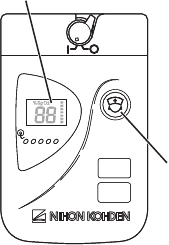
48 Operator’s Manual ZM-920PA/921PA/930PA/931PA
Turning SpO2 Data and Pulse Level Bar Graph
Display On/Off
You can turn off the display of SpO2 data and pulse level bar graph on the LCD.
Press the CALL key for more than 3
seconds within 10 seconds after turning
transmitter power on (after a “peep”
sound).
“%SpO2” is not displayed. When SpO2
monitoring starts, SpO2 data and pulse
level bar graph are not displayed on the
LCD.
To turn SpO2 display on, turn the
transmitter power off and turn the power
on again.
RA LA LL Va Vb
USAch
E002
1395.025 MHz
CALL key
SpO2 display off
RA LA LL Va Vb
USAch
E002
1395.025 MHz
CALL key
SpO2 display off
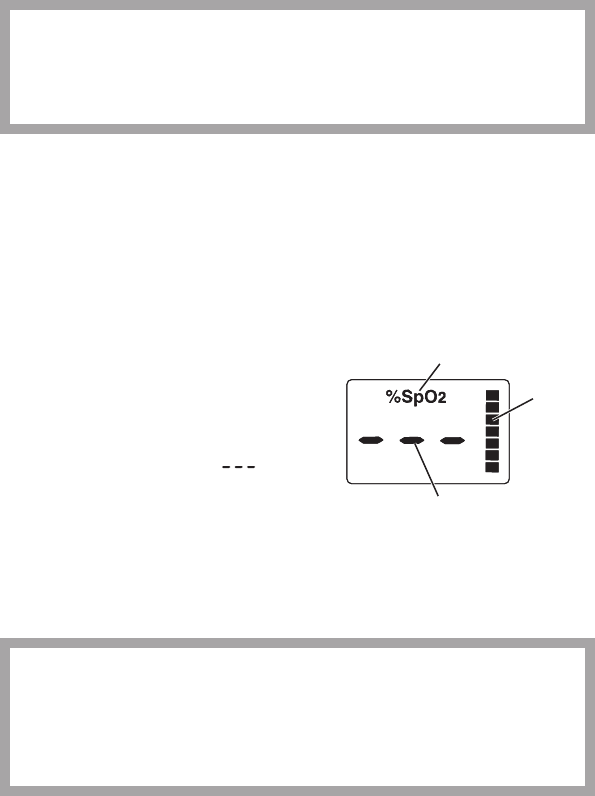
Operator’s Manual ZM-920PA/921PA/930PA/931PA 49
Detecting and Displaying Measurement Condition
External Light Noise Alarm
CAUTION
Normal external light does not affect monitoring but strong light such
as a surgical light or sunlight may affect monitoring. If affected, cover
the measuring site with a blanket.
Strongexternallight(surgicallightorinvertertypeuorescentlamp,etc.),may
affect SpO2 monitoring. When external light is too strong to correctly measure
SpO2, the transmitter generates an alarm tone (“pip” sound every 0.5 seconds).
Cover the probe attachment site with blanket or cloth.
Insufficient Light Alarm
Whensufcientlightcannotbeobtainedfromthephotoemitteroftheprobe,the
transmitter generates the following sound and indication.
(1) “peep” sound (every 1 second)
(2) pulse level bar graph is maximum
(all bars are lit.)
(3) SpO2 data is displayed as “ ”
(4) %SpO2 is blinking.
In this case, change the attachment site to the appropriate site. Refer to the
operator’s manual of the SpO2 probe.
Probe Malfunction Alarm
CAUTION
When any of the following conditions occurs, the probe may be
broken. Replace it with a new one.
• The transmitter generates “pip” sounds.
• SpO2 data is 85% and blinking.
(2)
(3)
(4)
(2)
(3)
(4)

50 Operator’s Manual ZM-920PA/921PA/930PA/931PA
When Measurement Condition is Unstable
SpO2 data blinks every 1 second when SpO2 signal stability decreases and
the transmitter cannot detect correct pulse waveform because of patient body
movement, poor attachment condition or poor circulation condition at the probe
attachment site.
CAUTION
SpO2 data blinking every second indicates an unstable pulse
waveform and displayed SpO2 value may be inaccurate. The
displayed data might not reflect sudden SpO2 changes.
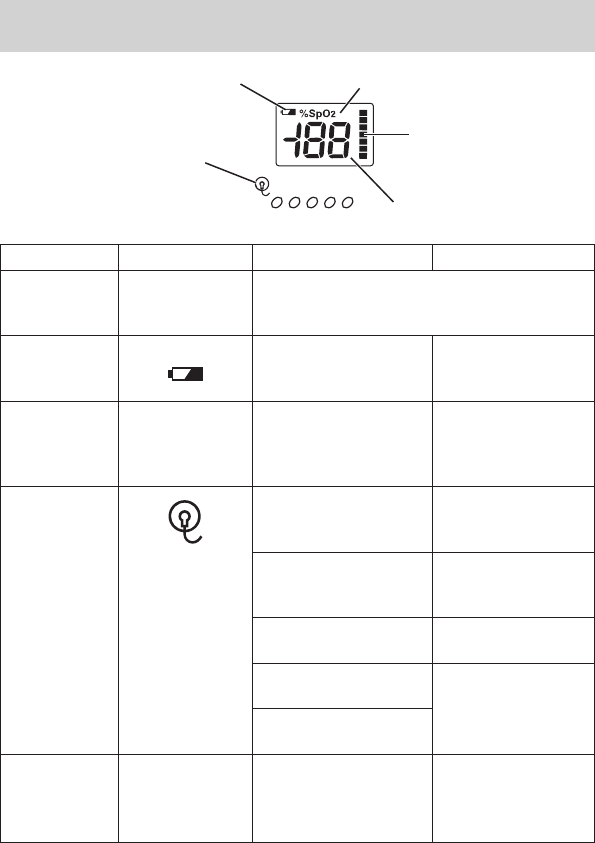
Operator’s Manual ZM-920PA/921PA/930PA/931PA 51
Alarm List
RA LA LL Va Vb
(1)
Displayed as LED on
ZM-920PA/921PA
(2)
(3) SpO2 data
(4) pulse level bar graph
(5) %SpO2 indication
Sound Display Cause Countermeasure
Single “peep”
sound
for 4 s
--- The CALL key is pressed. The sound lasts while
the key is pressed.
--- (1) The battery voltage
decreases and battery
charge is almost zero.
Replace the batteries
with new ones.
Continuous
“peep” sound
All lights are off Battery is completely
discharged.
Replace the batteries
with new ones. To
stop the sound, turn
off the power.
--- (2) Electrode lead is
disconnected from the
electrode.
Firmly connect the
electrode lead to the
electrode.
Electrode lead is
disconnected from the
transmitter.
Firmly connect the
electrode lead to the
transmitter.
Electrode lead
discontinuity
Replace the electrode
lead with a new one.
Electrodeisnotrmly
attached to the skin.
Replace the electrode
with a new one.
Polarization voltage is
abnormally high.
Intermittent
“pip” sound
every 0.5 s
--- SpO2 measurement site
isunderuorescent
light, surgical light,
sunlight, etc.
Cover the
measurement site
with a blanket or
cloth.

52 Operator’s Manual ZM-920PA/921PA/930PA/931PA
Sound Display Cause Countermeasure
Intermittent
“peep” sound
every 1 s
(3)
(4) all lit
(5) blinking
Cannot receive
sufcientlightfromthe
probe photo emitter.
Attach probe to a
site with 6 to 14
mm thickness where
sufcientlightcanbe
received.
Intermittent
“pip” sound
every 0.25 s
(3) 85%, blinking Broken probe Replace the probe
with a new one.
--- (3) blinking Patient body movement Remove the cause
by checking the
patient condition
and changing the
attachment site.
Probe is not attached
securely.
Securely attach the
probe.

Operator’s Manual ZM-920PA/921PA/930PA/931PA 53
Troubleshooting
If the problem still remains after checking the following, contact your Nihon
Kohden representative.
Problem Cause Countermeasure
The power cannot be
turned on.
Batteries are not
installed correctly.
The battery polarity is
wrong.
Install the batteries correctly.
Batteries are
completely
discharged.
Replace the batteries with new ones.
Nothing is displayed on
the LCD after turning the
power on. (ZM-930PA/
931PA only)
SpO2 display is turned
off.
Turn off the power, and turn on the
power again.
Nothing is displayed on
the monitor after turning
the transmitter power on.
The channel of the
transmitter and
monitor does not
match.
Set the correct channel on the
monitor.
Signal receiving condition
is poor.
Electrode lead is
not connected to the
transmitter.
Connect the electrode lead to the
transmitter. ECG electrode lead works
as an antenna for transmitting data
to the receiving monitor. If ECG is
not measured, the signal may not be
received.
Another transmitter
of the same channel is
used near by.
Turn the transmitter power off. If the
monitor still receives a signal, there
is a high probability that another
transmitter of the same channel is
used nearby.
Follow the instruction of your
channel administrator and use another
transmitter of a different channel.
Signals are mixing. Follow the instruction of your
channel administrator and use another
transmitter of a different channel.
The transmitter is
damaged.
Contact your Nihon Kohden
representative.

54 Operator’s Manual ZM-920PA/921PA/930PA/931PA
Problem Cause Countermeasure
3 electrode leads are
properly attached to the
patient but LEDs light.
The transmitter
isxedto6lead
monitoring.
Turn off and on the transmitter power.
Heart rate of the rate of the
patient who is using an
electric blanket cannot
be monitored on the
receiving monitor.
Pacing pulse detection
is set to ON on the
monitor.
Turn off the pacing pulse detection.
ECG baseline is thick.
(Hum is overlapping)
The gel on the
electrode is dried out.
Replace the electrode with a new one.
The gel on the
electrode is coming
off.
Electric blanket is
used.
Cover the blanket with a shield cover.
Humlterissetto
OFF on the monitor
SettheltertoON.
Respiration waveform
measurement is unstable.
The gel on the
electrode is dried out.
Replace the electrode with a new one.
The gel on the
electrode is coming
off.
SpO2 data is unstable and
not reliable.
The probe size is not
appropriate for the
patient.
Use the appropriate probe for the
patient.
Probe is attached to
the same limb that
is used for NIBP
measurement.
Attach the probe to the opposite limb.
Avoid a site where blood circulation
condition changes greatly.
Probe attachment
condition is poor.
Probe is about to
detach from the skin.
External light gets in.
Firmly attach the probe according to
the procedure in the probe operator’s’ss
manual.
Measurement site
is dirty. Patient is
wearing nail polish.
Remove dirt and nail polish.

Operator’s Manual ZM-920PA/921PA/930PA/931PA 55
Changing the Transmitter Channel
The transmitter channel can be changed by the QI-901PK Channel Writer. To
change the channel number, refer to the channel writer manual.
WARNING
The following actions must be taken to properly receive the
transmitter signal of the correct patient on the receiving instrument.
Otherwise, there may be signal loss or signals may mix causing a
serious accident, such as monitoring a different patient.
• Assign a channel administrator in the hospital and only he or she
should manage channel assignment.
• The channel administrator must manage the channels in the facility
so that there is no signal interference.
• When the transmitter channel is changed, the channel
administrator must check that the channel on the receiving monitor
is also changed and the signal is properly received.
• The channel administrator must replace the channel number label
on the transmitter with the new one after changing the channel.

56 Operator’s Manual ZM-920PA/921PA/930PA/931PA
Lifetime and Disposal
Disposing of Used Batteries
Replacement
When the “ ” LED is lit or the “ ” is displayed on the LCD during operation,
the batteries are running out.
Replace the batteries with new ones. When using rechargeable batteries, recharge
them.
Disposal
Beforedisposingofthebatteries,checkwithyourlocalsolidwasteofcials
for details in your area for proper disposal. It may be illegal to dispose of these
batteries in the municipal waste stream.
Disposing of Electrodes and SpO2 Probes
Refer to the manual of each item.

Operator’s Manual ZM-920PA/921PA/930PA/931PA 57
Cleaning, Disinfection and Sterilization
Transmitter and Electrode Lead
CAUTION
If detergent or liquid spills into the transmitter, clean it and dry it
completely before use. If a wet transmitter is used, the transmitter
may malfunction or get damaged.
CAUTION
Before cleaning or disinfection, remove the batteries from the
transmitter. Failure to follow this instruction may result in electrical
shock or transmitter malfunction.
CAUTION
The transmitter cannot be sterilized. Sterilizing the transmitter may
damage it.
CAUTION
Dispose of the transmitter, options and accessories as specified by
Nihon Kohden. Otherwise, it causes infection or environmental
contamination.
Before cleaning or disinfecting, remove the batteries from the transmitter. Be
careful not to let any liquid get inside the transmitter.
Cleaning
Wipe the transmitter and electrode leads with a soft cloth moistened with
disinfecting alcohol or neutral detergent diluted with water. After cleaning, dry
them completely.

58 Operator’s Manual ZM-920PA/921PA/930PA/931PA
Disinfection
CAUTION
• Do not immerse the electrode lead connector in liquid.
• Do not disinfect with hypochlorous acid.
• Use the recommended concentration.
Wipe the outside surface of the transmitter and electrode lead with a non-abrasive
cloth moistened with any of the disinfectants listed on the next page. Use the
recommended concentration.
Disinfectant Concentration (%)
Glutaraldehyde solution 2.0
Alkyldiaminoethylglycine hydrochloride 0.5
Benzalkonium chloride 0.2
Benzethonium chloride solution 0.2
Chlorhexidine gluconate solution 0.5
SpO2 Probe
Refer to the probe manual.

Operator’s Manual ZM-920PA/921PA/930PA/931PA 59
Replacing the Battery Case Cover
When the battery case cover is damaged, replace it with a new one.
Battery case cover, code no. 6113-046365C.
Other than the battery case cover, there are no serviceable parts for the transmitter.
Repair Parts Availability Policy
Nihon Kohden Corporation (NKC) shall stock repair parts (parts necessary
to maintain the performance of the instrument) for a period of 6 years after
NKC announces discontinuation of the instrument. In that period, NKC or its
distributors will repair the instrument. This period may be shorter than 6 years if
the necessary board or part is not available. For discontinuation announcements,
contact your Nihon Kohden distributor or representative.

60 Operator’s Manual ZM-920PA/921PA/930PA/931PA
Specifications
ZM-920PA/930PA
ECG measurement
Channels: 4
Input range: ±5 mV or more
DC offset: ±500 mV or more
Inputimpedance: 5MΩormore(5Hz)
Pacing pulse detection: ANSI/AAMI EC13
Based upon Pacemaker pulse rejection Capability
Respiration measurement
Measuring method: Impedance method
Impedancerange: 0to2kΩ
SpO2 measurement
Measuring range: 0 to 100%, in 1% steps
Measuring accuracy
When the measuring accuracy of the SpO2 probe is not considered:
±1digit(80%≤SpO2≤100%)
±2digit(50%≤SpO2≤80%)
Lessthan50%isnotspecied
When the measuring accuracy of the SpO2 probe is considered:
±2digit(80%≤SpO2≤100%)
±3digit(70%≤SpO2≤80%)
Lessthan70%isnotspecied
Transmitter
FCC regulation: FCC part 95 Subpart-H
Wireless Medical Telemetry Service (WMTS)
Field strength limits: <200 mV/m (at 3 m)
Undesiredemission: below960MHz:200μV/m(at3m)
above960MHz: 500μV/m(at3m)
Operator’s Manual ZM-920PA/921PA/930PA/931PA 61
Antenna: ECG electrode lead
Transmission channel: Indicated on the transmitter
Transmission frequency range: 608.0250 to 613.9750 MHz
Channel spacing: 50 kHz or 37.5 kHz (12.5 kHz when interleaved)
Modulation scheme: FSK (Frequency Shift Keying)
Occupied bandwidth: <20 kHz
Effective radiated power: 1.0 mW (conducted)
Safety standards
Safety standard: CSA C22.2 No. 601-1 M90: 1994
IEC 60601-1: 1988
IEC 60601-1 Amendment 1: 1991
IEC 60601-1 Amendment 2: 1995
IEC 60601-1-2: 1993
IEC 60601-2-27: 1994
According to the type of protection against electrical shock:
INTERNALLY POWERED EQUIPMENT
According to the degree of protection against electrical shock:
ECG/impedance method respiration: DEFIBRILLATION-PROOF
TYPE CF APPLIED PART
SpO2: DEFIBRILLATION-PROOF
TYPE BF APPLIED PART
According to the degree of protection against harmful ingress of water:
IPX0 (Ordinary equipment)
According to the degree of safety of application in the presence of a
FLAMMABLE ANAESTHETIC MIXTURE WITH AIR, OR WITH OXYGEN
OR NITROUS OXIDE: Equipment not suitable for use in the presence of
FLAMMABLE ANAESTHETIC MIXTURE
WITH AIR, OR WITH OXYGEN OR NITROUS
OXIDE
According to the mode of operation: CONTINUOUS OPERATION
Water resistance
Water does not get inside the transmitter except for the battery case when
immersed in water up to 30 cm deep for 3 minutes.
62 Operator’s Manual ZM-920PA/921PA/930PA/931PA
Power requirements
Battery type: two AA type alkaline dry cell batteries,
manganese dry cell batteries, NiCd rechargeable
batteries, NiMH batteries
Battery lifetime:
ZM-930PA: approximately 3 days
(with alkaline batteries, measuring ECG,
respiration and SpO2 of approximately 60 kg
weightadultmalepatientatthepointingnger)
approximately 4 days
(with alkaline batteries, measuring ECG and
respiration only)
ZM-920PA: approximately 4 days
Environment
Operating environment
Operating temperature: 5 to 40°C, 41 to 104°F
Operating humidity: 30 to 85% (non-condensing)
Operating atmospheric pressure: 70 to 106 kPa
Operating voltage: 1.6 to 3.2 V
Storage environment
Storagetemperature: −20to65°C,−4to149°F
Storage humidity: 15 to 95%
Storage atmospheric pressure: 70 to 106 kPa
Dimension and Weight
Dimension: 78 W × 122 H × 26 D (mm)
Weight (without batteries): ZM-930PA: about 180 g
ZM-920PA: about 165 g
Operator’s Manual ZM-920PA/921PA/930PA/931PA 63
ZM-921PA/931PA
ECG Measurement
Channels: 4
Input range: ±5 mV or more
DC offset: ±500 mV or more
Inputimpedance: 5MΩormore(5Hz)
Pacing pulse detection: ANSI/AAMI EC13
Based upon Pacemaker pulse rejection Capability
Respiration Measurement
Measuring method: Impedance method
Impedancerange: 0to2kΩ
SpO2 Measurement
Measuring range: 0 to 100%, in 1% steps
Measuring accuracy
When the measuring accuracy of the SpO2 probe is not considered:
±1digit(80%≤SpO2≤100%)
±2digit(50%≤SpO2≤80%)
Lessthan50%isnotspecied
When the measuring accuracy of the SpO2 probe is considered:
±2digit(80%≤SpO2≤100%)
±3digit(70%≤SpO2≤80%)
Lessthan70%isnotspecied
Transmitter
FCC regulation: FCC part 95 Subpart-H
Wireless Medical Telemetry Service (WMTS)
Field strength limits: <740 mV/m (at 3 m)
Undesiredemission: below960MHz:200μV/m(at3m)
above960MHz:500μV/m(at3m)
Antenna: Internal
Transmission channel: indicated on the transmitter
Transmission frequency range: 1395.0250 to 1399.9750 MHz
1427.0250 to 1431.9750 MHz
64 Operator’s Manual ZM-920PA/921PA/930PA/931PA
Channel spacing: 50 kHz or 37.5 kHz (12.5 kHz when interleaved)
Modulation scheme: FSK (Frequency Shift Keying)
Occupied bandwidth: <20 kHz
Effective radiated power: 5.0 mW (factory default setting)
Can be changed to 1.0 mW if required
Safety Standards
Safety standard: CAN/CSA-C22.2 No. 601-1 M90: 1990
CAN/CSA-C22.2 No. 601-1. 1S1-94: 1994
CAN/CSA-C22.2 No. 601-1. 1B-90: R2002
CAN/CSA-C22.2 No. 60601-2-49-04: 2004
CAN/CSA-C22.2 No. 601.2.27-98: 1998
IEC 60601-1: 1988
IEC 60601-1 Amendment 1: 1991
IEC 60601-1 Amendment 2: 1995
IEC 60601-1-2: 2001
IEC 60601-1-2 Amendment 1: 2004
IEC 60601-2-27: 2005
IEC 60601-2-49: 2001
ISO 9919: 2005
According to the type of protection against electrical shock:
INTERNALLY POWERED EQUIPMENT
According to the degree of protection against electrical shock:
ECG/impedance method respiration: DEFIBRILLATION-PROOF
TYPE CF APPLIED PART
SpO2: DEFIBRILLATION-PROOF
TYPE BF APPLIED PART
According to the degree of protection against harmful ingress of water:
IPX0 (Ordinary equipment)
According to the degree of safety of application in the presence of a
FLAMMABLE ANAESTHETIC MIXTURE WITH AIR, OR WITH OXYGEN
OR NITROUS OXIDE: Equipment not suitable for use in the presence of
FLAMMABLE ANAESTHETIC MIXTURE
WITH AIR, OR WITH OXYGEN OR NITROUS
OXIDE
According to the mode of operation: CONTINUOUS OPERATION
Operator’s Manual ZM-920PA/921PA/930PA/931PA 65
Water Resistance
Water does not get inside the transmitter except for the battery case when
immersed in water up to 30 cm deep for 3 minutes.
Power Requirements
Battery type: two AA type alkaline dry cell batteries,
manganese dry cell batteries, NiCd rechargeable
batteries, NiMH batteries
Battery lifetime:
ZM-931PA: approximately 2.5 days
(with alkaline batteries, measuring ECG,
respiration and SpO2 of approximately 60 kg
weightadultmalepatientatthepointingnger)
approximately 3.5 days
(with alkaline batteries, measuring ECG and
respiration only)
ZM-921PA: approximately 3.5 days
Environment
Operating environment
Operating temperature: 5 to 40°C, 41 to 104°F
Operating humidity: 30 to 85% (non-condensing)
Operating atmospheric pressure: 70 to 106 kPa
Operating voltage: 1.6 to 3.2 V
Storage environment
Storagetemperature: −20to65°C,−4to149°F
Storage humidity: 15 to 95%
Storage atmospheric pressure: 70 to 106 kPa
Dimension and Weight
Dimension: 78 W × 122 H × 26 D (mm)
Weight (without batteries): ZM-931PA: about 190 g
ZM-921PA: about 170 g

66 Operator’s Manual ZM-920PA/921PA/930PA/931PA
Electromagnetic Compatibility
IEC 60601-1-2: 2001
IEC 60601-1-2 Amendment 1: 2004
Electromagnetic Emissions
This Model ZM-921PA/931PA is intended for use in the electromagnetic
environmentspeciedbelow.ThecustomerortheuseroftheZM-921PA/931PA
should assure that it is used in such an environment.
Emissions test Compliance Electromagnetic environment guidance
RF emissions
CISPR 111
Group 1roup 1oup 1 The ZM-921PA/931PA uses RF energy onlyZM-921PA/931PA uses RF energy only uses RF energy only
for its internal function. Therefore, its RF internal function. Therefore, its RFinternal function. Therefore, its RF Therefore, its RFTherefore, its RF
emissions are very low and are not likely to low and are not likely tolow and are not likely to and are not likely toand are not likely to
cause any interference in nearby electronicnterference in nearby electronicterference in nearby electronicference in nearby electronicerence in nearby electronicn nearby electronic nearby electronicroniconic
equipment..
RF emissions
CISPR 11111
Class Blass B The ZM-921PA/931PA is suitable for usee ZM-921PA/931PA is suitable for use ZM-921PA/931PA is suitable for useZM-921PA/931PA is suitable for use is suitable for usele for usee for use
in all establishments, including domesticll establishments, including domesticl establishments, including domestic establishments, including domesticestablishments, including domesticts, including domestics, including domestic including domesticincluding domestic
establishments.
Harmonic emissions
IEC 61000-3-2000-3-20-3-22
Not
applicable
Voltageuctuations/
ickeremissions
IEC 61000-3-3
Not
applicable
Electromagnetic Immunity
This Model ZM-921PA/931PA is intended for use in the electromagnetic
environmentspeciedbelow.ThecustomerortheuseroftheZM-921PA/931PA
should assure that it is used in such an environment.
Immunity test IEC 60601 test
level
Compliance
level
Electromagnetic
environment -
guidance
Electrostatic
discharge (ESD)
IEC 61000-4-2
±6 kV contact
±8 kV air
±6 kV contact
±8 kV air
Floors should be wood,
concrete or ceramic tile.
Ifoorsarecovered
with synthetic material,
the relative humidity
should be at least 30%.

Operator’s Manual ZM-920PA/921PA/930PA/931PA 67
Immunity test IEC 60601 test
level
Compliance
level
Electromagnetic
environment -
guidance
Electrical fast
transient/ burst
IEC 61000-4-4
±2 kV for power
supply lines
±1 kV for input/
output lines
Not applicable
—
Surge
IEC 61000-4-5
±1 kV differential
mode
±2 kV common
mode
Not applicable
—
Voltage
dips, short
interruptions
and voltage
variations on
power supply
input lines
IEC 61000-4-11
<5% UT (>95% dip
in UT) for 0.5 cycle
40% UT (60% dip
in UT) for 5 cycles
70% UT (30% dip
in UT) for 25 cycles
<5% UT (>95% dip
in UT) for 5 s
Not applicable
—
Power
frequency
(50/60 Hz)
magneticeld
IEC 61000-4-8
3 A/m 3 A/m Power frequency
magneticelds
should be at levels
characteristic of a
typical location in a
typical commercial or
hospital environment.
NOTE: UT is the AC mains voltage prior to application of the test level
Avoiding Electromagnetic Interference (Impedance Respiration)
Impedance respiration measurement is very sensitive and affected by
electromagnetic interference. Technological limitations do not allow immunity
levelshigherthan1V/mforradiatedRFelectromagneticelds.Electromagnetic
eldswitheldstrengthsabove1V/mmaycausemeasurementerror.Donotuse
electrically radiating equipment near the impedance respiration measurements.

68 Operator’s Manual ZM-920PA/921PA/930PA/931PA
Immunity
test
IEC 60601
test level
Compliance
level
Electromagnetic environment
- guidance
Conducted RF
IEC 61000-4-6
Radiated RF
IEC 61000-4-3
3 Vrms
3 V/m
80 MHz to
2.5 GHz
3 Vrms
3 V/m 80 MHz
to 2.5 GHz
(1 V/m 80 MHz
to 2.5 GHz for
respiration)
Portable and mobile RF
communications equipment should be
used no closer to any part of the ZM-
921PA/931PA, including cables, than
the recommended separation distance
calculated from the equation applicable
to the frequency of the transmitter.
Recommended separation
distance
d = 1.2√P
d = 1.2√P 80 MHz to 800 MHz
d = 2.3√P 800 MHz to 2.5 GHz
(d = 3.5√P 80 MHz to 800 MHz for
respiration
d = 7.0√P 800 MHz to 2.5 GHz for
respiration)
where P is the maximum output
power rating of the transmitter in
watts (W) according to the transmitter
manufacturer and d is the recommended
separation distance in meters (m).
FieldstrengthsfromxedRF
transmitters, as deter mined by an
electromagnetic site survey*1, should be
less than the compliance level in each
frequency range*2.
Interference may occur in the vicinity of
equipment marked with the following
symbol:

Operator’s Manual ZM-920PA/921PA/930PA/931PA 69
Immunity
test
IEC 60601
test level
Compliance
level
Electromagnetic environment
- guidance
NOTE 1: At 80 MHz and 800 MHz, the higher frequency range applies.
NOTE 2: These guidelines may not apply in all situations. Electromagnetic propagation
isaffectedbyabsorptionandreectionfromstructures,objectsandpeople.
*1 Fieldstrengthsfromxedtransmitters,suchasbasestationsforradio(cellular/
cordless) telephones and land mobile radios, amateur radio, AM and FM radio
broadcast and TV broadcast cannot be predicted theoretically with accuracy.
ToassesstheelectromagneticenvironmentduetoxedRFtransmitters,an
electromagneticsitesurveyshouldbeconsidered.Ifthemeasuredeldstrength
in the location in which the ZM-921PA/931PA is used exceeds the applicable RF
compliance level above, the ZM-921PA/931PA should be observed to verify normal
operation. If abnormal performance is observed, additional measures may be
necessary, such as re-orienting or relocating the ZM-921PA/931PA.
*2 Overthefrequencyrange150kHzto80MHz,eldstrengthsshouldbelessthan1
V/m for respiration and 3 V/m for all other functions.

70 Operator’s Manual ZM-920PA/921PA/930PA/931PA
Recommended Separation Distances between Portable and Mobile
RF Communications Equipment
The ZM-921PA/931PA is intended for use in an electromagnetic environment in
which radiated RF disturbances are controlled. The customer or the user of the
ZM-921PA/931PA can help prevent electromagnetic interference by maintaining
a minimum distance between portable and mobile RF communications equipment
(transmitters) and the ZM-921PA/931PA as recommended below, according to the
maximum output power of the communications.
Rated
maximum
output power
of transmitter
(W)
Separation distance according to frequency of transmitter (m)
150 kHz to 80 MHz
d = 1.2√P
80 MHz to 800 MHz
d = 1.2√P
(For respiration:
d = 3.5√P)
800 MHz to 2.5 GHz
d = 2.3√P
(For respiration:
d = 7.0√P)
0.01 0.12 0.12 (0.35*) 0.23 (0.7*)
0.1 0.38 0.38 (1.1*) 0.73 (2.2*)
1 1.2 1.2 (3.5*) 2.3 (7.0*)
10 3.8 3.8 (11*) 7.3 (22*)
100 12 12 (35*) 23 (70*)
For transmitters rated at a maximum output power not listed above, the recommended
separation distance d in meters (m) can be estimated using the equation applicable to
the frequency of the transmitter, where P is the maximum output power rating of the
transmitter in watts (W) according to the transmitter manufacturer.
(* For respiration)
NOTE 1: At 80 MHz and 800 MHz, the separation distance for the higher frequency
range applies.
NOTE 2: These guidelines may not apply in all situations. Electromagnetic propagation
isaffectedbyabsorptionandreectionfromstructures,objectsandpeople.
Recovery Time after Defibrillation
The transmitter returns to the normal operating mode within 10 seconds after
debrillation.Thestoredsettingsarenotaffected.

Operator’s Manual ZM-920PA/921PA/930PA/931PA 71
System Composition for EMC Test
The ZM-921PA/931PA bedside monitor is tested to comply with IEC 60601-1-2:
2001 and IEC 60601-1-2 Amendment 1: 2004 with the following composition.
Units Cable length
ZM-921PA/931PA transmitter —
BR-906P ECG electrode lead 0.8 m
TL-201Tngerprobe 1.6 m

72 Operator’s Manual ZM-920PA/921PA/930PA/931PA
Standard Accessories
Name Q’ty Supply code
Strap 1 Y233

Operator’s Manual ZM-920PA/921PA/930PA/931PA 73
Options
CAUTION
Use only Nihon Kohden electrodes, electrode leads and SpO2 probes
to assure maximum performance from your instrument.
Transmitter
Channel writer, QI-901PK
ECG/RESP
Name Application Model Q’ty Supply
code
Electrode
lead
3 electrodes, clip type,
lead length 80 cm BR-903PA 1 K911A
3 electrodes, snap type,
lead length 80 cm BR-913PA 1 K910B
6 electrodes, clip type,
lead length 80 cm BR-906PA 1 K912A
6 electrodes, snap type,
lead length 80 cm BR-916PA 1 K915A

74 Operator’s Manual ZM-920PA/921PA/930PA/931PA
SpO2
Name Cable
length
Model/
Code No. Q’ty Supply
Code No.
Finger probe (reusable) 0.6 m TL-201T
1
P225H
1.6 m P225F
Multi-site probe (reusable) 1.6 m TL-220T P225G
Finger probe (reusable)
0.6 m TL-630T1 P310A
1.6 m TL-630T3 P310C
0.6 m TL-631T1 P311A
1.6 m TL-631T3 P311C
SpO2 probe (for adult, disposable)
1.6 m
TL-251T
5
P201A
SpO2 probe (for child, disposable) TL-252T P201B
SpO2 probe (for neonate,
disposable) TL-253T P201C
SpO2 probe (for adult, disposable) 0.8 m TL-271T
24
P203A
1.6 m TL-271T3 P203E
SpO2 probe (for child, disposable) 0.8 m TL-272T P203B
1.6 m TL-272T3 P203F
SpO2 probe (for neonate/adult,
disposable)
0.8 m TL-273T P203C
1.6 m TL-273T3 P203G
SpO2 probe (for child/infant,
disposable)
0.8 m TL-274T P203D
1.6 m TL-274T3 P203H
SpO2 probe (for adult/neonate,
disposable)
0.8 m TL-051S
5
P228A
1.6 m TL-052S P228B
SpO2 probe (for child/infant,
disposable)
0.8 m TL-061S P229A
1.6 m TL-062S P229B
COTTONY tape
—
340703 20 P259
Foam tape for TL-051S/052S/
061S/062S —
4 × 25
packages P260
Attachment tape for TL-220T/
251T/252T/253T/630T/631T
3 × 30
packages P263
Probe fastener YS-093P2 30 P267
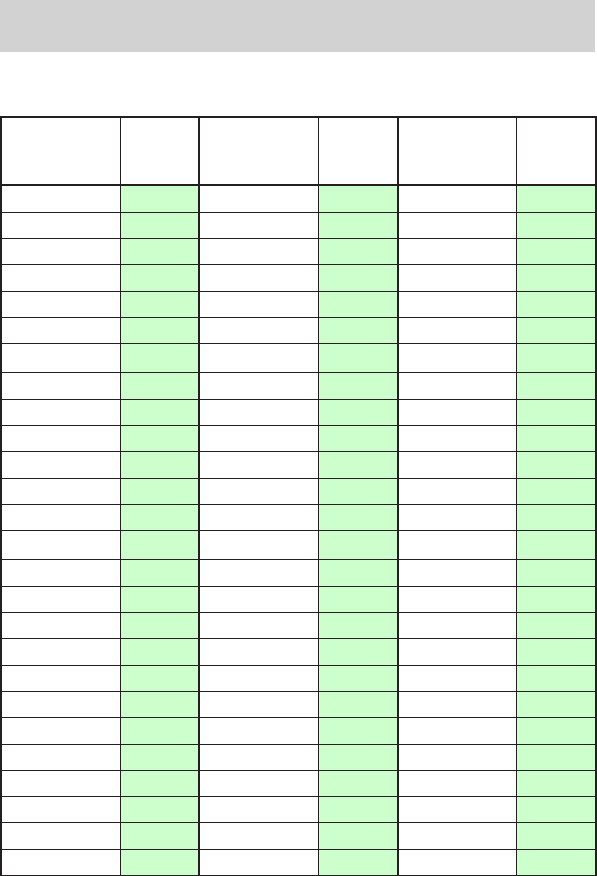
Operator’s Manual ZM-920PA/921PA/930PA/931PA 75
Transmission Frequencies
Channel: 9002 to 9478
Transmission
frequency
(MHz)
Channel
No.
Transmission
frequency
(MHz)
Channel
No.
Transmission
frequency
(MHz)
Channel
No.
608.0250 9002 608.3500 9028 608.6750 9054
608.0375 9003 608.3625 9029 608.6875 9055
608.0500 9004 608.3750 9030 608.7000 9056
608.0625 9005 608.3875 9031 608.7125 9057
608.0750 9006 608.4000 9032 608.7250 9058
608.0875 9007 608.4125 9033 608.7375 9059
608.1000 9008 608.4250 9034 608.7500 9060
608.1125 9009 608.4375 9035 608.7625 9061
608.1250 9010 608.4500 9036 608.7750 9062
608.1375 9011 608.4625 9037 608.7875 9063
608.1500 9012 608.4750 9038 608.8000 9064
608.1625 9013 608.4875 9039 608.8125 9065
608.1750 9014 608.5000 9040 608.8250 9066
608.1875 9015 608.5125 9041 608.8375 9067
608.2000 9016 608.5250 9042 608.8500 9068
608.2125 9017 608.5375 9043 608.8625 9069
608.2250 9018 608.5500 9044 608.8750 9070
608.2375 9019 608.5625 9045 608.8875 9071
608.2500 9020 608.5750 9046 608.9000 9072
608.2625 9021 608.5875 9047 608.9125 9073
608.2750 9022 608.6000 9048 608.9250 9074
608.2875 9023 608.6125 9049 608.9375 9075
608.3000 9024 608.6250 9050 608.9500 9076
608.3125 9025 608.6375 9051 608.9625 9077
608.3250 9026 608.6500 9052 608.9750 9078
608.3375 9027 608.6625 9053 608.9875 9079

76 Operator’s Manual ZM-920PA/921PA/930PA/931PA
Transmission
frequency
(MHz)
Channel
No.
Transmission
frequency
(MHz)
Channel
No.
Transmission
frequency
(MHz)
Channel
No.
609.0000 9080 609.3750 9110 609.7500 9140
609.0125 9081 609.3875 9111 609.7625 9141
609.0250 9082 609.4000 9112 609.7750 9142
609.0375 9083 609.4125 9113 609.7875 9143
609.0500 9084 609.4250 9114 609.8000 9144
609.0625 9085 609.4375 9115 609.8125 9145
609.0750 9086 609.4500 9116 609.8250 9146
609.0875 9087 609.4625 9117 609.8375 9147
609.1000 9088 609.4750 9118 609.8500 9148
609.1125 9089 609.4875 9119 609.8625 9149
609.1250 9090 609.5000 9120 609.8750 9150
609.1375 9091 609.5125 9121 609.8875 9151
609.1500 9092 609.5250 9122 609.9000 9152
609.1625 9093 609.5375 9123 609.9125 9153
609.1750 9094 609.5500 9124 609.9250 9154
609.1875 9095 609.5625 9125 609.9375 9155
609.2000 9096 609.5750 9126 609.9500 9156
609.2125 9097 609.5875 9127 609.9625 9157
609.2250 9098 609.6000 9128 609.9750 9158
609.2375 9099 609.6125 9129 609.9875 9159
609.2500 9100 609.6250 9130 610.0000 9160
609.2625 9101 609.6375 9131 610.0125 9161
609.2750 9102 609.6500 9132 610.0250 9162
609.2875 9103 609.6625 9133 610.0375 9163
609.3000 9104 609.6750 9134 610.0500 9164
609.3125 9105 609.6875 9135 610.0625 9165
609.3250 9106 609.7000 9136 610.0750 9166
609.3375 9107 609.7125 9137 610.0875 9167
609.3500 9108 609.7250 9138 610.1000 9168
609.3625 9109 609.7375 9139 610.1125 9169

Operator’s Manual ZM-920PA/921PA/930PA/931PA 77
Transmission
frequency
(MHz)
Channel
No.
Transmission
frequency
(MHz)
Channel
No.
Transmission
frequency
(MHz)
Channel
No.
610.1250 9170 610.5000 9200 610.8750 9230
610.1375 9171 610.5125 9201 610.8875 9231
610.1500 9172 610.5250 9202 610.9000 9232
610.1625 9173 610.5375 9203 610.9125 9233
610.1750 9174 610.5500 9204 610.9250 9234
610.1875 9175 610.5625 9205 610.9375 9235
610.2000 9176 610.5750 9206 610.9500 9236
610.2125 9177 610.5875 9207 610.9625 9237
610.2250 9178 610.6000 9208 610.9750 9238
610.2375 9179 610.6125 9209 610.9875 9239
610.2500 9180 610.6250 9210 611.0000 9240
610.2625 9181 610.6375 9211 611.0125 9241
610.2750 9182 610.6500 9212 611.0250 9242
610.2875 9183 610.6625 9213 611.0375 9243
610.3000 9184 610.6750 9214 611.0500 9244
610.3125 9185 610.6875 9215 611.0625 9245
610.3250 9186 610.7000 9216 611.0750 9246
610.3375 9187 610.7125 9217 611.0875 9247
610.3500 9188 610.7250 9218 611.1000 9248
610.3625 9189 610.7375 9219 611.1125 9249
610.3750 9190 610.7500 9220 611.1250 9250
610.3875 9191 610.7625 9221 611.1375 9251
610.4000 9192 610.7750 9222 611.1500 9252
610.4125 9193 610.7875 9223 611.1625 9253
610.4250 9194 610.8000 9224 611.1750 9254
610.4375 9195 610.8125 9225 611.1875 9255
610.4500 9196 610.8250 9226 611.2000 9256
610.4625 9197 610.8375 9227 611.2125 9257
610.4750 9198 610.8500 9228 611.2250 9258
610.4875 9199 610.8625 9229 611.2375 9259

78 Operator’s Manual ZM-920PA/921PA/930PA/931PA
Transmission
frequency
(MHz)
Channel
No.
Transmission
frequency
(MHz)
Channel
No.
Transmission
frequency
(MHz)
Channel
No.
611.2500 9260 611.6250 9290 612.0000 9320
611.2625 9261 611.6375 9291 612.0125 9321
611.2750 9262 611.6500 9292 612.0250 9322
611.2875 9263 611.6625 9293 612.0375 9323
611.3000 9264 611.6750 9294 612.0500 9324
611.3125 9265 611.6875 9295 612.0625 9325
611.3250 9266 611.7000 9296 612.0750 9326
611.3375 9267 611.7125 9297 612.0875 9327
611.3500 9268 611.7250 9298 612.1000 9328
611.3625 9269 611.7375 9299 612.1125 9329
611.3750 9270 611.7500 9300 612.1250 9330
611.3875 9271 611.7625 9301 612.1375 9331
611.4000 9272 611.7750 9302 612.1500 9332
611.4125 9273 611.7875 9303 612.1625 9333
611.4250 9274 611.8000 9304 612.1750 9334
611.4375 9275 611.8125 9305 612.1875 9335
611.4500 9276 611.8250 9306 612.2000 9336
611.4625 9277 611.8375 9307 612.2125 9337
611.4750 9278 611.8500 9308 612.2250 9338
611.4875 9279 611.8625 9309 612.2375 9339
611.5000 9280 611.8750 9310 612.2500 9340
611.5125 9281 611.8875 9311 612.2625 9341
611.5250 9282 611.9000 9312 612.2750 9342
611.5375 9283 611.9125 9313 612.2875 9343
611.5500 9284 611.9250 9314 612.3000 9344
611.5625 9285 611.9375 9315 612.3125 9345
611.5750 9286 611.9500 9316 612.3250 9346
611.5875 9287 611.9625 9317 612.3375 9347
611.6000 9288 611.9750 9318 612.3500 9348
611.6125 9289 611.9875 9319 612.3625 9349

Operator’s Manual ZM-920PA/921PA/930PA/931PA 79
Transmission
frequency
(MHz)
Channel
No.
Transmission
frequency
(MHz)
Channel
No.
Transmission
frequency
(MHz)
Channel
No.
612.3750 9350 612.7500 9380 613.1250 9410
612.3875 9351 612.7625 9381 613.1375 9411
612.4000 9352 612.7750 9382 613.1500 9412
612.4125 9353 612.7875 9383 613.1625 9413
612.4250 9354 612.8000 9384 613.1750 9414
612.4375 9355 612.8125 9385 613.1875 9415
612.4500 9356 612.8250 9386 613.2000 9416
612.4625 9357 612.8375 9387 613.2125 9417
612.4750 9358 612.8500 9388 613.2250 9418
612.4875 9359 612.8625 9389 613.2375 9419
612.5000 9360 612.8750 9390 613.2500 9420
612.5125 9361 612.8875 9391 613.2625 9421
612.5250 9362 612.9000 9392 613.2750 9422
612.5375 9363 612.9125 9393 613.2875 9423
612.5500 9364 612.9250 9394 613.3000 9424
612.5625 9365 612.9375 9395 613.3125 9425
612.5750 9366 612.9500 9396 613.3250 9426
612.5875 9367 612.9625 9397 613.3375 9427
612.6000 9368 612.9750 9398 613.3500 9428
612.6125 9369 612.9875 9399 613.3625 9429
612.6250 9370 613.0000 9400 613.3750 9430
612.6375 9371 613.0125 9401 613.3875 9431
612.6500 9372 613.0250 9402 613.4000 9432
612.6625 9373 613.0375 9403 613.4125 9433
612.6750 9374 613.0500 9404 613.4250 9434
612.6875 9375 613.0625 9405 613.4375 9435
612.7000 9376 613.0750 9406 613.4500 9436
612.7125 9377 613.0875 9407 613.4625 9437
612.7250 9378 613.1000 9408 613.4750 9438
612.7375 9379 613.1125 9409 613.4875 9439
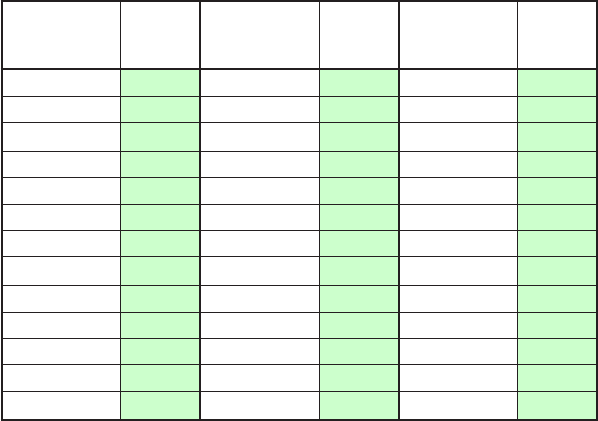
80 Operator’s Manual ZM-920PA/921PA/930PA/931PA
Transmission
frequency
(MHz)
Channel
No.
Transmission
frequency
(MHz)
Channel
No.
Transmission
frequency
(MHz)
Channel
No.
613.5000 9440 613.6625 9453 613.8250 9466
613.5125 9441 613.6750 9454 613.8375 9467
613.5250 9442 613.6875 9455 613.8500 9468
613.5375 9443 613.7000 9456 613.8625 9469
613.5500 9444 613.7125 9457 613.8750 9470
613.5625 9445 613.7250 9458 613.8875 9471
613.5750 9446 613.7375 9459 613.9000 9472
613.5875 9447 613.7500 9460 613.9125 9473
613.6000 9448 613.7625 9461 613.9250 9474
613.6125 9449 613.7750 9462 613.9375 9475
613.6250 9450 613.7875 9463 613.9500 9476
613.6375 9451 613.8000 9464 613.9625 9477
613.6500 9452 613.8125 9465 613.9750 9478

Operator’s Manual ZM-920PA/921PA/930PA/931PA 81
Channel: E002 to E398
Transmission
frequency
(MHz)
Channel
No.
Transmission
frequency
(MHz)
Channel
No.
Transmission
frequency
(MHz)
Channel
No.
1395.0250 E002 1395.3875 E031 1395.7500 E060
1395.0375 E003 1395.4000 E032 1395.7625 E061
1395.0500 E004 1395.4125 E033 1395.7750 E062
1395.0625 E005 1395.4250 E034 1395.7875 E063
1395.0750 E006 1395.4375 E035 1395.8000 E064
1395.0875 E007 1395.4500 E036 1395.8125 E065
1395.1000 E008 1395.4625 E037 1395.8250 E066
1395.1125 E009 1395.4750 E038 1395.8375 E067
1395.1250 E010 1395.4875 E039 1395.8500 E068
1395.1375 E011 1395.5000 E040 1395.8625 E069
1395.1500 E012 1395.5125 E041 1395.8750 E070
1395.1625 E013 1395.5250 E042 1395.8875 E071
1395.1750 E014 1395.5375 E043 1395.9000 E072
1395.1875 E015 1395.5500 E044 1395.9125 E073
1395.2000 E016 1395.5625 E045 1395.9250 E074
1395.2125 E017 1395.5750 E046 1395.9375 E075
1395.2250 E018 1395.5875 E047 1395.9500 E076
1395.2375 E019 1395.6000 E048 1395.9625 E077
1395.2500 E020 1395.6125 E049 1395.9750 E078
1395.2625 E021 1395.6250 E050 1395.9875 E079
1395.2750 E022 1395.6375 E051 1396.0000 E080
1395.2875 E023 1395.6500 E052 1396.0125 E081
1395.3000 E024 1395.6625 E053 1396.0250 E082
1395.3125 E025 1395.6750 E054 1396.0375 E083
1395.3250 E026 1395.6875 E055 1396.0500 E084
1395.3375 E027 1395.7000 E056 1396.0625 E085
1395.3500 E028 1395.7125 E057 1396.0750 E086
1395.3625 E029 1395.7250 E058 1396.0875 E087
1395.3750 E030 1395.7375 E059 1396.1000 E088

82 Operator’s Manual ZM-920PA/921PA/930PA/931PA
Transmission
frequency
(MHz)
Channel
No.
Transmission
frequency
(MHz)
Channel
No.
Transmission
frequency
(MHz)
Channel
No.
1396.1125 E089 1396.4875 E119 1396.8625 E149
1396.1250 E090 1396.5000 E120 1396.8750 E150
1396.1375 E091 1396.5125 E121 1396.8875 E151
1396.1500 E092 1396.5250 E122 1396.9000 E152
1396.1625 E093 1396.5375 E123 1396.9125 E153
1396.1750 E094 1396.5500 E124 1396.9250 E154
1396.1875 E095 1396.5625 E125 1396.9375 E155
1396.2000 E096 1396.5750 E126 1396.9500 E156
1396.2125 E097 1396.5875 E127 1396.9625 E157
1396.2250 E098 1396.6000 E128 1396.9750 E158
1396.2375 E099 1396.6125 E129 1396.9875 E159
1396.2500 E100 1396.6250 E130 1397.0000 E160
1396.2625 E101 1396.6375 E131 1397.0125 E161
1396.2750 E102 1396.6500 E132 1397.0250 E162
1396.2875 E103 1396.6625 E133 1397.0375 E163
1396.3000 E104 1396.6750 E134 1397.0500 E164
1396.3125 E105 1396.6875 E135 1397.0625 E165
1396.3250 E106 1396.7000 E136 1397.0750 E166
1396.3375 E107 1396.7125 E137 1397.0875 E167
1396.3500 E108 1396.7250 E138 1397.1000 E168
1396.3625 E109 1396.7375 E139 1397.1125 E169
1396.3750 E110 1396.7500 E140 1397.1250 E170
1396.3875 E111 1396.7625 E141 1397.1375 E171
1396.4000 E112 1396.7750 E142 1397.1500 E172
1396.4125 E113 1396.7875 E143 1397.1625 E173
1396.4250 E114 1396.8000 E144 1397.1750 E174
1396.4375 E115 1396.8125 E145 1397.1875 E175
1396.4500 E116 1396.8250 E146 1397.2000 E176
1396.4625 E117 1396.8375 E147 1397.2125 E177
1396.4750 E118 1396.8500 E148 1397.2250 E178

Operator’s Manual ZM-920PA/921PA/930PA/931PA 83
Transmission
frequency
(MHz)
Channel
No.
Transmission
frequency
(MHz)
Channel
No.
Transmission
frequency
(MHz)
Channel
No.
1397.2375 E179 1397.6125 E209 1397.9875 E239
1397.2500 E180 1397.6250 E210 1398.0000 E240
1397.2625 E181 1397.6375 E211 1398.0125 E241
1397.2750 E182 1397.6500 E212 1398.0250 E242
1397.2875 E183 1397.6625 E213 1398.0375 E243
1397.3000 E184 1397.6750 E214 1398.0500 E244
1397.3125 E185 1397.6875 E215 1398.0625 E245
1397.3250 E186 1397.7000 E216 1398.0750 E246
1397.3375 E187 1397.7125 E217 1398.0875 E247
1397.3500 E188 1397.7250 E218 1398.1000 E248
1397.3625 E189 1397.7375 E219 1398.1125 E249
1397.3750 E190 1397.7500 E220 1398.1250 E250
1397.3875 E191 1397.7625 E221 1398.1375 E251
1397.4000 E192 1397.7750 E222 1398.1500 E252
1397.4125 E193 1397.7875 E223 1398.1625 E253
1397.4250 E194 1397.8000 E224 1398.1750 E254
1397.4375 E195 1397.8125 E225 1398.1875 E255
1397.4500 E196 1397.8250 E226 1398.2000 E256
1397.4625 E197 1397.8375 E227 1398.2125 E257
1397.4750 E198 1397.8500 E228 1398.2250 E258
1397.4875 E199 1397.8625 E229 1398.2375 E259
1397.5000 E200 1397.8750 E230 1398.2500 E260
1397.5125 E201 1397.8875 E231 1398.2625 E261
1397.5250 E202 1397.9000 E232 1398.2750 E262
1397.5375 E203 1397.9125 E233 1398.2875 E263
1397.5500 E204 1397.9250 E234 1398.3000 E264
1397.5625 E205 1397.9375 E235 1398.3125 E265
1397.5750 E206 1397.9500 E236 1398.3250 E266
1397.5875 E207 1397.9625 E237 1398.3375 E267
1397.6000 E208 1397.9750 E238 1398.3500 E268

84 Operator’s Manual ZM-920PA/921PA/930PA/931PA
Transmission
frequency
(MHz)
Channel
No.
Transmission
frequency
(MHz)
Channel
No.
Transmission
frequency
(MHz)
Channel
No.
1398.3625 E269 1398.7375 E299 1399.1125 E329
1398.3750 E270 1398.7500 E300 1399.1250 E330
1398.3875 E271 1398.7625 E301 1399.1375 E331
1398.4000 E272 1398.7750 E302 1399.1500 E332
1398.4125 E273 1398.7875 E303 1399.1625 E333
1398.4250 E274 1398.8000 E304 1399.1750 E334
1398.4375 E275 1398.8125 E305 1399.1875 E335
1398.4500 E276 1398.8250 E306 1399.2000 E336
1398.4625 E277 1398.8375 E307 1399.2125 E337
1398.4750 E278 1398.8500 E308 1399.2250 E338
1398.4875 E279 1398.8625 E309 1399.2375 E339
1398.5000 E280 1398.8750 E310 1399.2500 E340
1398.5125 E281 1398.8875 E311 1399.2625 E341
1398.5250 E282 1398.9000 E312 1399.2750 E342
1398.5375 E283 1398.9125 E313 1399.2875 E343
1398.5500 E284 1398.9250 E314 1399.3000 E344
1398.5625 E285 1398.9375 E315 1399.3125 E345
1398.5750 E286 1398.9500 E316 1399.3250 E346
1398.5875 E287 1398.9625 E317 1399.3375 E347
1398.6000 E288 1398.9750 E318 1399.3500 E348
1398.6125 E289 1398.9875 E319 1399.3625 E349
1398.6250 E290 1399.0000 E320 1399.3750 E350
1398.6375 E291 1399.0125 E321 1399.3875 E351
1398.6500 E292 1399.0250 E322 1399.4000 E352
1398.6625 E293 1399.0375 E323 1399.4125 E353
1398.6750 E294 1399.0500 E324 1399.4250 E354
1398.6875 E295 1399.0625 E325 1399.4375 E355
1398.7000 E296 1399.0750 E326 1399.4500 E356
1398.7125 E297 1399.0875 E327 1399.4625 E357
1398.7250 E298 1399.1000 E328 1399.4750 E358
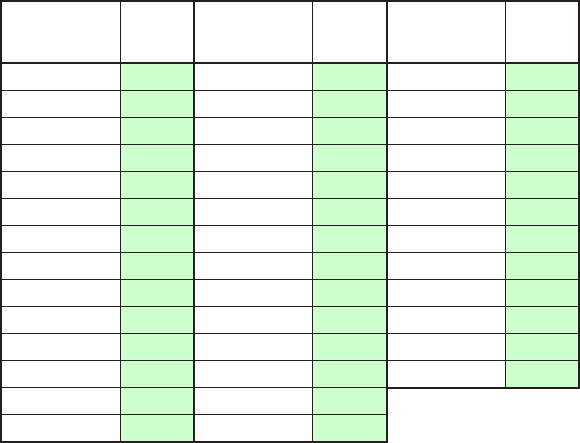
Operator’s Manual ZM-920PA/921PA/930PA/931PA 85
Transmission
frequency
(MHz)
Channel
No.
Transmission
frequency
(MHz)
Channel
No.
Transmission
frequency
(MHz)
Channel
No.
1399.4875 E359 1399.6625 E373 1399.8375 E387
1399.5000 E360 1399.6750 E374 1399.8500 E388
1399.5125 E361 1399.6875 E375 1399.8625 E389
1399.5250 E362 1399.7000 E376 1399.8750 E390
1399.5375 E363 1399.7125 E377 1399.8875 E391
1399.5500 E364 1399.7250 E378 1399.9000 E392
1399.5625 E365 1399.7375 E379 1399.9125 E393
1399.5750 E366 1399.7500 E380 1399.9250 E394
1399.5875 E367 1399.7625 E381 1399.9375 E395
1399.6000 E368 1399.7750 E382 1399.9500 E396
1399.6125 E369 1399.7875 E383 1399.9625 E397
1399.6250 E370 1399.8000 E384 1399.9750 E398
1399.6375 E371 1399.8125 E385
1399.6500 E372 1399.8250 E386

86 Operator’s Manual ZM-920PA/921PA/930PA/931PA
Channel: E502 to E898
Transmission
frequency
(MHz)
Channel
No.
Transmission
frequency
(MHz)
Channel
No.
Transmission
frequency
(MHz)
Channel
No.
1427.0250 E502 1427.3875 E531 1427.7500 E560
1427.0375 E503 1427.4000 E532 1427.7625 E561
1427.0500 E504 1427.4125 E533 1427.7750 E562
1427.0625 E505 1427.4250 E534 1427.7875 E563
1427.0750 E506 1427.4375 E535 1427.8000 E564
1427.0875 E507 1427.4500 E536 1427.8125 E565
1427.1000 E508 1427.4625 E537 1427.8250 E566
1427.1125 E509 1427.4750 E538 1427.8375 E567
1427.1250 E510 1427.4875 E539 1427.8500 E568
1427.1375 E511 1427.5000 E540 1427.8625 E569
1427.1500 E512 1427.5125 E541 1427.8750 E570
1427.1625 E513 1427.5250 E542 1427.8875 E571
1427.1750 E514 1427.5375 E543 1427.9000 E572
1427.1875 E515 1427.5500 E544 1427.9125 E573
1427.2000 E516 1427.5625 E545 1427.9250 E574
1427.2125 E517 1427.5750 E546 1427.9375 E575
1427.2250 E518 1427.5875 E547 1427.9500 E576
1427.2375 E519 1427.6000 E548 1427.9625 E577
1427.2500 E520 1427.6125 E549 1427.9750 E578
1427.2625 E521 1427.6250 E550 1427.9875 E579
1427.2750 E522 1427.6375 E551 1428.0000 E580
1427.2875 E523 1427.6500 E552 1428.0125 E581
1427.3000 E524 1427.6625 E553 1428.0250 E582
1427.3125 E525 1427.6750 E554 1428.0375 E583
1427.3250 E526 1427.6875 E555 1428.0500 E584
1427.3375 E527 1427.7000 E556 1428.0625 E585
1427.3500 E528 1427.7125 E557 1428.0750 E586
1427.3625 E529 1427.7250 E558 1428.0875 E587
1427.3750 E530 1427.7375 E559 1428.1000 E588

Operator’s Manual ZM-920PA/921PA/930PA/931PA 87
Transmission
frequency
(MHz)
Channel
No.
Transmission
frequency
(MHz)
Channel
No.
Transmission
frequency
(MHz)
Channel
No.
1428.1125 E589 1428.4875 E619 1428.8625 E649
1428.1250 E590 1428.5000 E620 1428.8750 E650
1428.1375 E591 1428.5125 E621 1428.8875 E651
1428.1500 E592 1428.5250 E622 1428.9000 E652
1428.1625 E593 1428.5375 E623 1428.9125 E653
1428.1750 E594 1428.5500 E624 1428.9250 E654
1428.1875 E595 1428.5625 E625 1428.9375 E655
1428.2000 E596 1428.5750 E626 1428.9500 E656
1428.2125 E597 1428.5875 E627 1428.9625 E657
1428.2250 E598 1428.6000 E628 1428.9750 E658
1428.2375 E599 1428.6125 E629 1428.9875 E659
1428.2500 E600 1428.6250 E630 1429.0000 E660
1428.2625 E601 1428.6375 E631 1429.0125 E661
1428.2750 E602 1428.6500 E632 1429.0250 E662
1428.2875 E603 1428.6625 E633 1429.0375 E663
1428.3000 E604 1428.6750 E634 1429.0500 E664
1428.3125 E605 1428.6875 E635 1429.0625 E665
1428.3250 E606 1428.7000 E636 1429.0750 E666
1428.3375 E607 1428.7125 E637 1429.0875 E667
1428.3500 E608 1428.7250 E638 1429.1000 E668
1428.3625 E609 1428.7375 E639 1429.1125 E669
1428.3750 E610 1428.7500 E640 1429.1250 E670
1428.3875 E611 1428.7625 E641 1429.1375 E671
1428.4000 E612 1428.7750 E642 1429.1500 E672
1428.4125 E613 1428.7875 E643 1429.1625 E673
1428.4250 E614 1428.8000 E644 1429.1750 E674
1428.4375 E615 1428.8125 E645 1429.1875 E675
1428.4500 E616 1428.8250 E646 1429.2000 E676
1428.4625 E617 1428.8375 E647 1429.2125 E677
1428.4750 E618 1428.8500 E648 1429.2250 E678

88 Operator’s Manual ZM-920PA/921PA/930PA/931PA
Transmission
frequency
(MHz)
Channel
No.
Transmission
frequency
(MHz)
Channel
No.
Transmission
frequency
(MHz)
Channel
No.
1429.2375 E679 1429.6125 E709 1429.9875 E739
1429.2500 E680 1429.6250 E710 1430.0000 E740
1429.2625 E681 1429.6375 E711 1430.0125 E741
1429.2750 E682 1429.6500 E712 1430.0250 E742
1429.2875 E683 1429.6625 E713 1430.0375 E743
1429.3000 E684 1429.6750 E714 1430.0500 E744
1429.3125 E685 1429.6875 E715 1430.0625 E745
1429.3250 E686 1429.7000 E716 1430.0750 E746
1429.3375 E687 1429.7125 E717 1430.0875 E747
1429.3500 E688 1429.7250 E718 1430.1000 E748
1429.3625 E689 1429.7375 E719 1430.1125 E749
1429.3750 E690 1429.7500 E720 1430.1250 E750
1429.3875 E691 1429.7625 E721 1430.1375 E751
1429.4000 E692 1429.7750 E722 1430.1500 E752
1429.4125 E693 1429.7875 E723 1430.1625 E753
1429.4250 E694 1429.8000 E724 1430.1750 E754
1429.4375 E695 1429.8125 E725 1430.1875 E755
1429.4500 E696 1429.8250 E726 1430.2000 E756
1429.4625 E697 1429.8375 E727 1430.2125 E757
1429.4750 E698 1429.8500 E728 1430.2250 E758
1429.4875 E699 1429.8625 E729 1430.2375 E759
1429.5000 E700 1429.8750 E730 1430.2500 E760
1429.5125 E701 1429.8875 E731 1430.2625 E761
1429.5250 E702 1429.9000 E732 1430.2750 E762
1429.5375 E703 1429.9125 E733 1430.2875 E763
1429.5500 E704 1429.9250 E734 1430.3000 E764
1429.5625 E705 1429.9375 E735 1430.3125 E765
1429.5750 E706 1429.9500 E736 1430.3250 E766
1429.5875 E707 1429.9625 E737 1430.3375 E767
1429.6000 E708 1429.9750 E738 1430.3500 E768

Operator’s Manual ZM-920PA/921PA/930PA/931PA 89
Transmission
frequency
(MHz)
Channel
No.
Transmission
frequency
(MHz)
Channel
No.
Transmission
frequency
(MHz)
Channel
No.
1430.3625 E769 1430.7375 E799 1431.1125 E829
1430.3750 E770 1430.7500 E800 1431.1250 E830
1430.3875 E771 1430.7625 E801 1431.1375 E831
1430.4000 E772 1430.7750 E802 1431.1500 E832
1430.4125 E773 1430.7875 E803 1431.1625 E833
1430.4250 E774 1430.8000 E804 1431.1750 E834
1430.4375 E775 1430.8125 E805 1431.1875 E835
1430.4500 E776 1430.8250 E806 1431.2000 E836
1430.4625 E777 1430.8375 E807 1431.2125 E837
1430.4750 E778 1430.8500 E808 1431.2250 E838
1430.4875 E779 1430.8625 E809 1431.2375 E839
1430.5000 E780 1430.8750 E810 1431.2500 E840
1430.5125 E781 1430.8875 E811 1431.2625 E841
1430.5250 E782 1430.9000 E812 1431.2750 E842
1430.5375 E783 1430.9125 E813 1431.2875 E843
1430.5500 E784 1430.9250 E814 1431.3000 E844
1430.5625 E785 1430.9375 E815 1431.3125 E845
1430.5750 E786 1430.9500 E816 1431.3250 E846
1430.5875 E787 1430.9625 E817 1431.3375 E847
1430.6000 E788 1430.9750 E818 1431.3500 E848
1430.6125 E789 1430.9875 E819 1431.3625 E849
1430.6250 E790 1431.0000 E820 1431.3750 E850
1430.6375 E791 1431.0125 E821 1431.3875 E851
1430.6500 E792 1431.0250 E822 1431.4000 E852
1430.6625 E793 1431.0375 E823 1431.4125 E853
1430.6750 E794 1431.0500 E824 1431.4250 E854
1430.6875 E795 1431.0625 E825 1431.4375 E855
1430.7000 E796 1431.0750 E826 1431.4500 E856
1430.7125 E797 1431.0875 E827 1431.4625 E857
1430.7250 E798 1431.1000 E828 1431.4750 E858
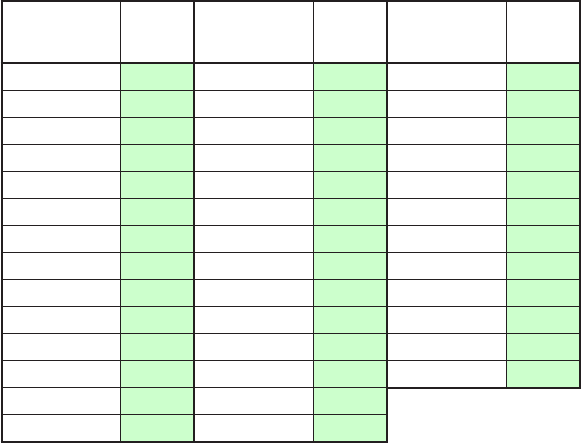
90 Operator’s Manual ZM-920PA/921PA/930PA/931PA
Transmission
frequency
(MHz)
Channel
No.
Transmission
frequency
(MHz)
Channel
No.
Transmission
frequency
(MHz)
Channel
No.
1431.4875 E859 1431.6625 E873 1431.8375 E887
1431.5000 E860 1431.6750 E874 1431.8500 E888
1431.5125 E861 1431.6875 E875 1431.8625 E889
1431.5250 E862 1431.7000 E876 1431.8750 E890
1431.5375 E863 1431.7125 E877 1431.8875 E891
1431.5500 E864 1431.7250 E878 1431.9000 E892
1431.5625 E865 1431.7375 E879 1431.9125 E893
1431.5750 E866 1431.7500 E880 1431.9250 E894
1431.5875 E867 1431.7625 E881 1431.9375 E895
1431.6000 E868 1431.7750 E882 1431.9500 E896
1431.6125 E869 1431.7875 E883 1431.9625 E897
1431.6250 E870 1431.8000 E884 1431.9750 E898
1431.6375 E871 1431.8125 E885
1431.6500 E872 1431.8250 E886